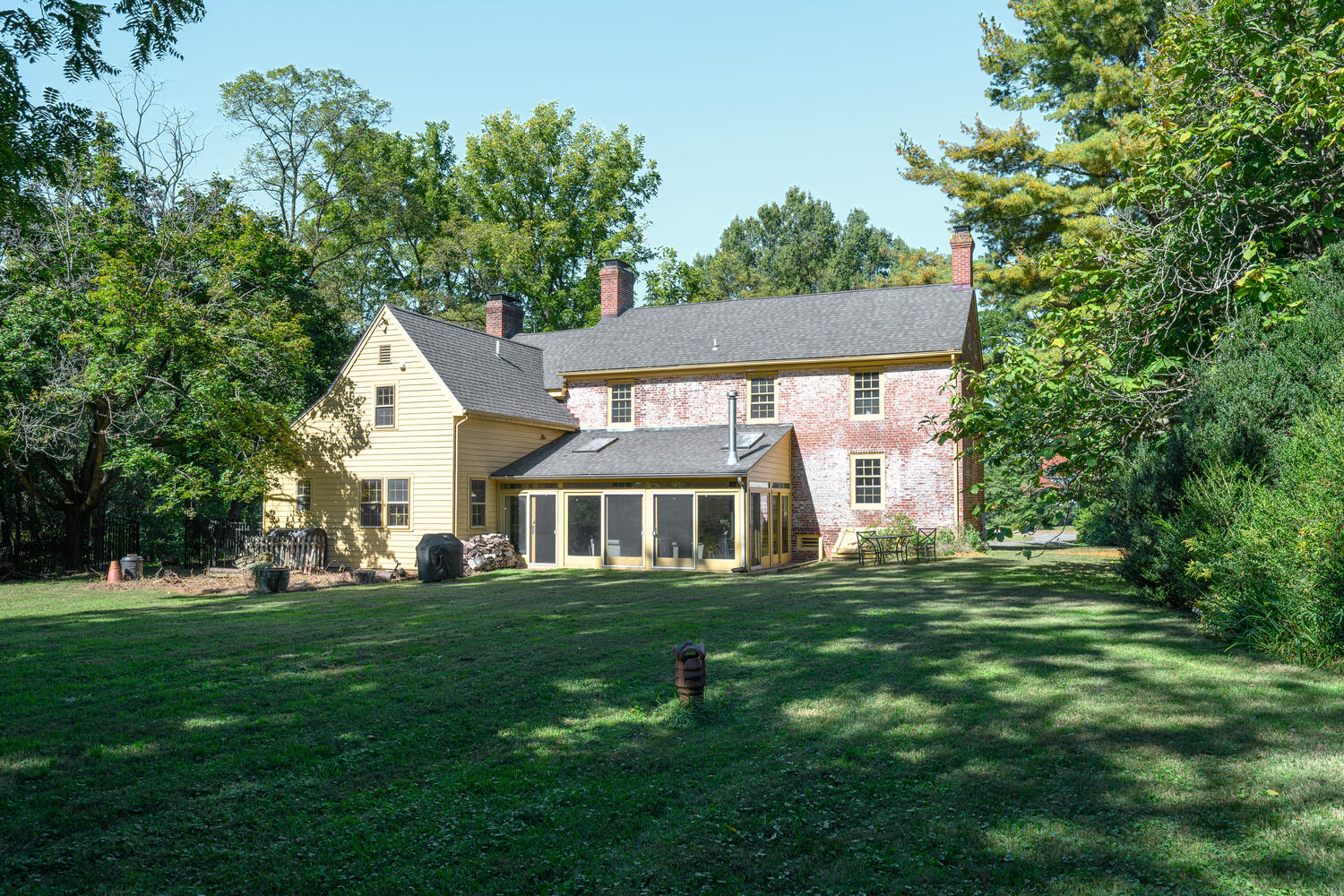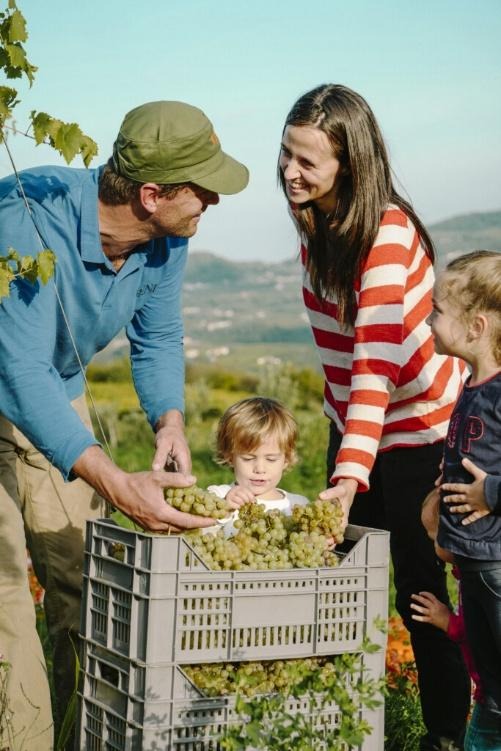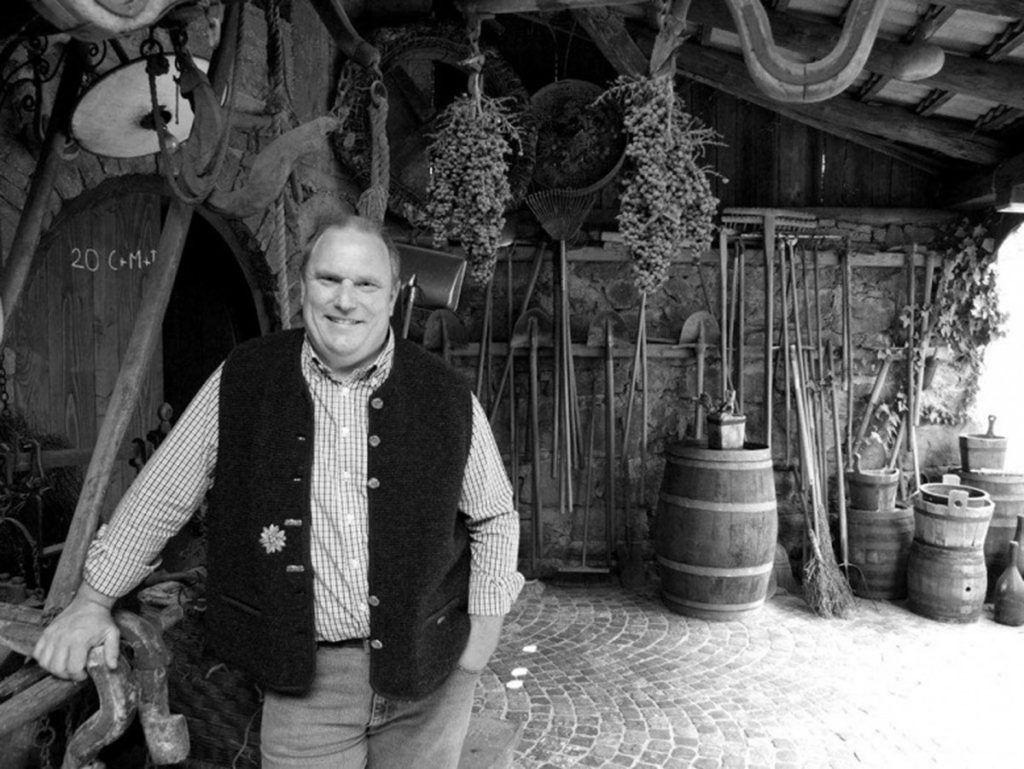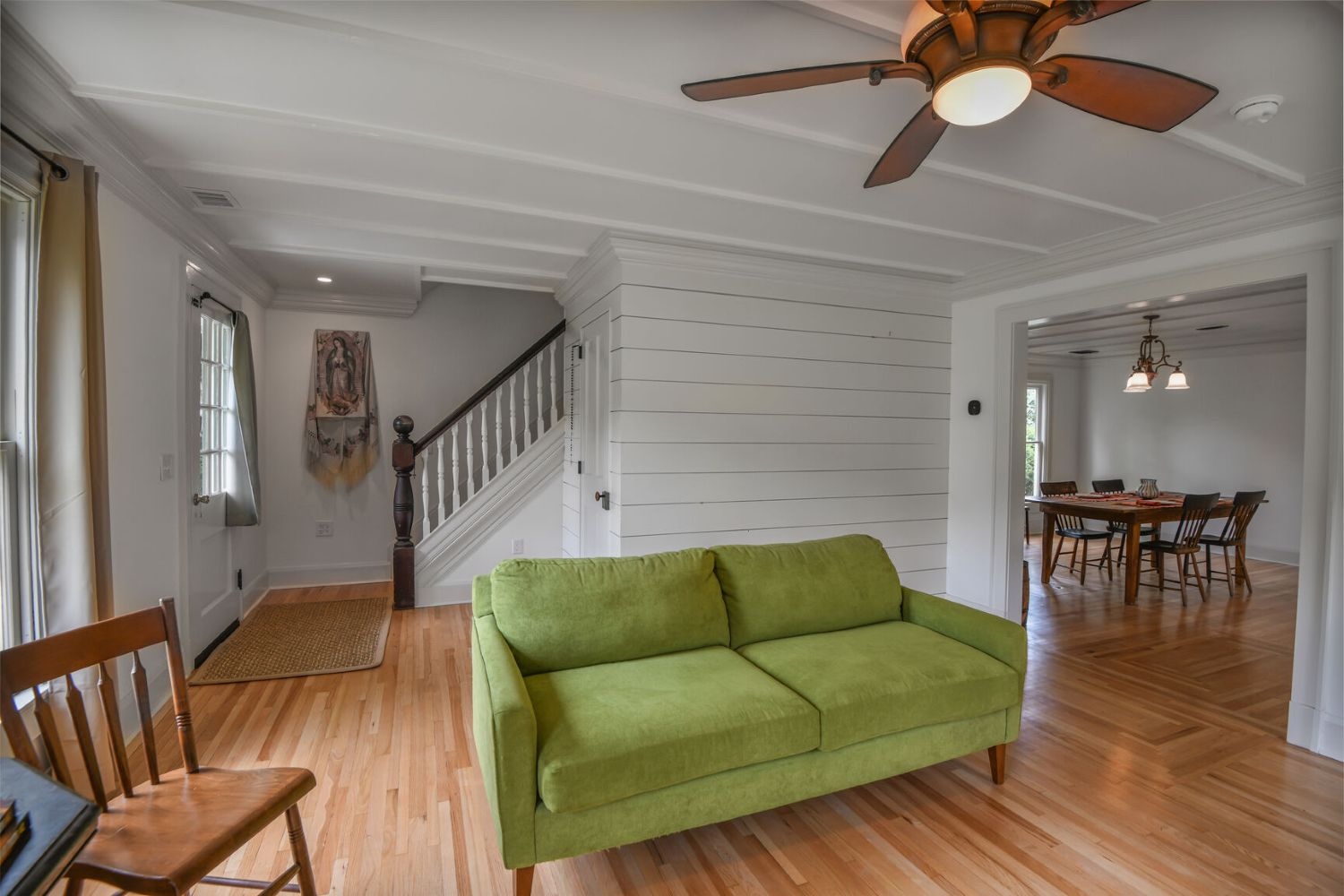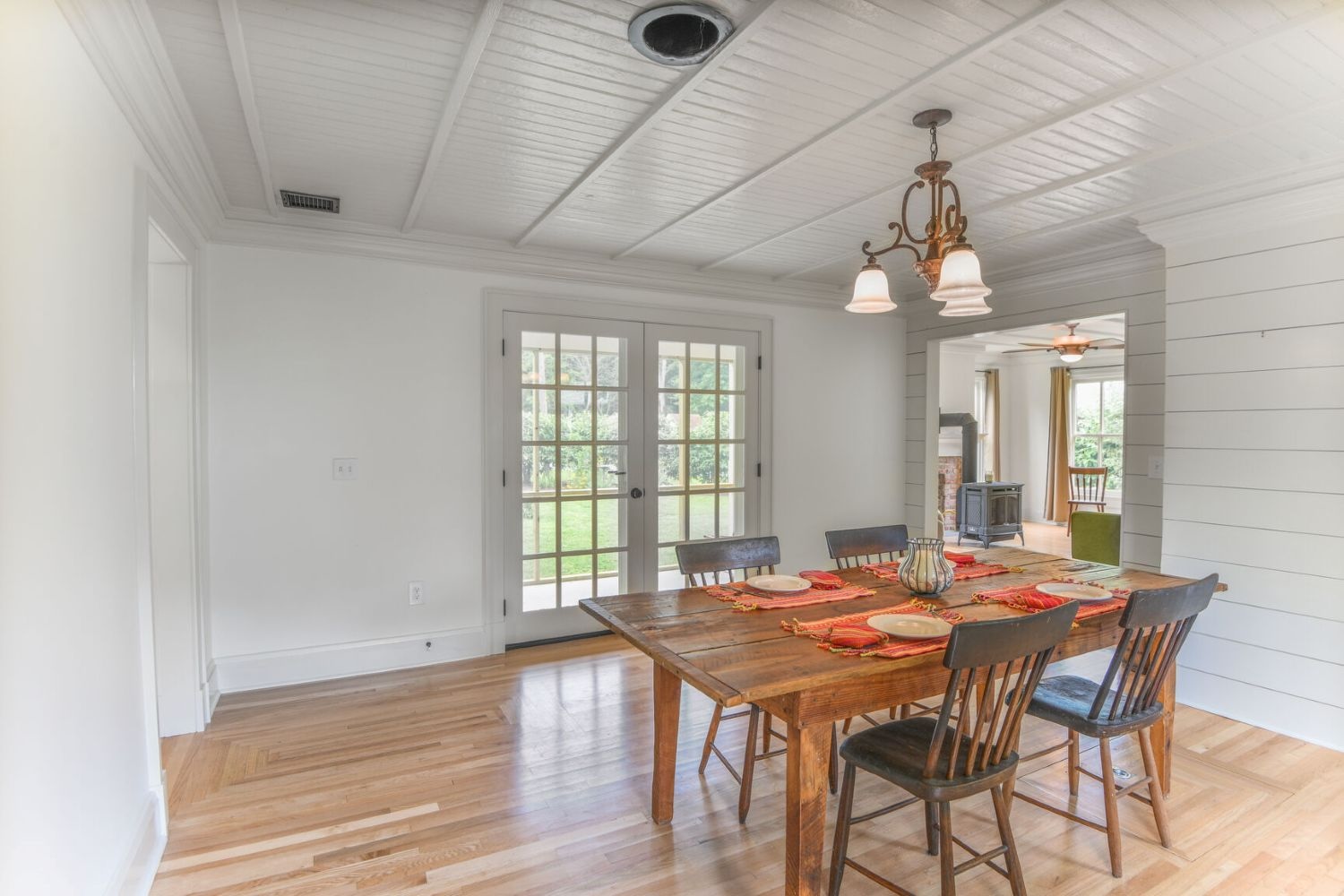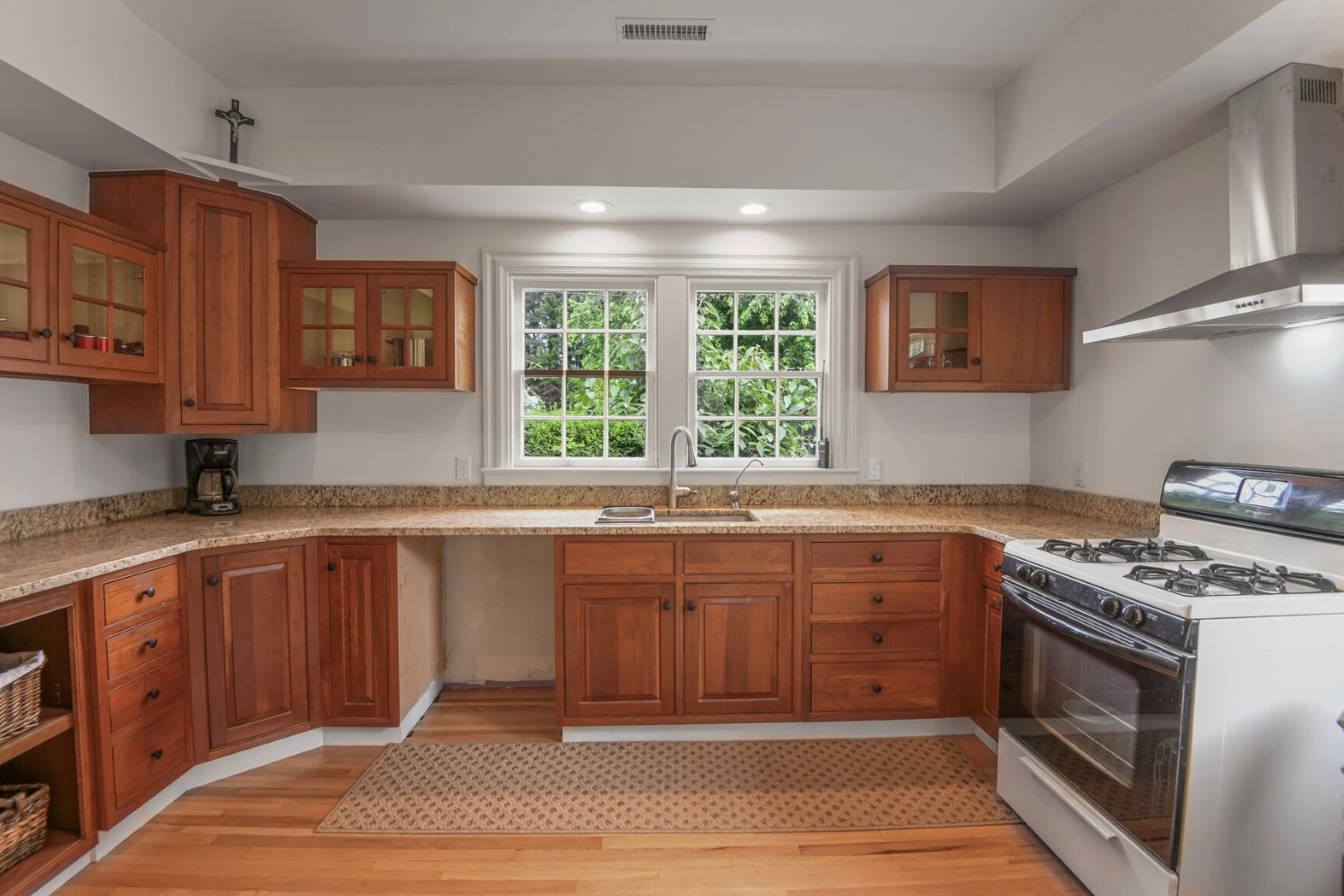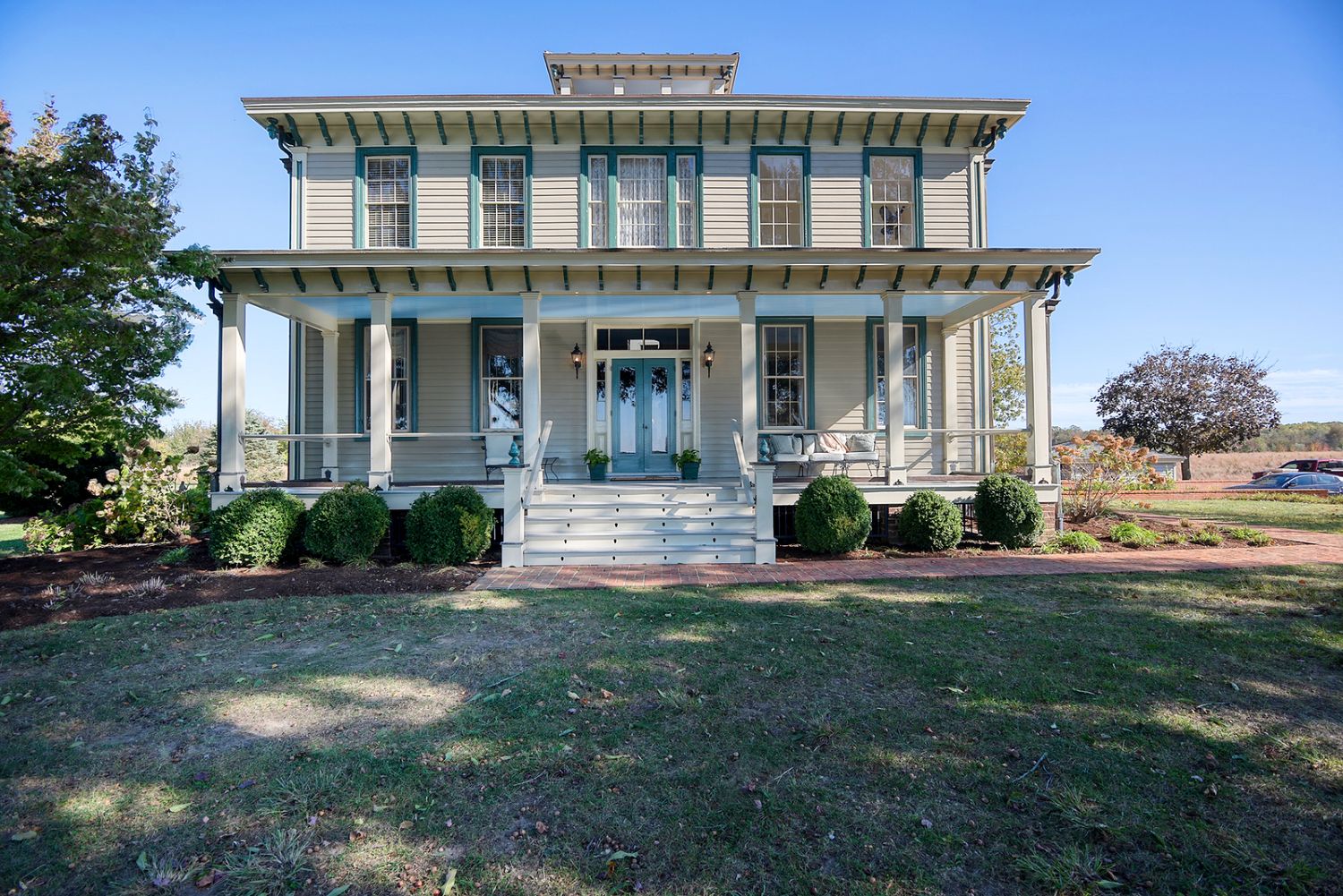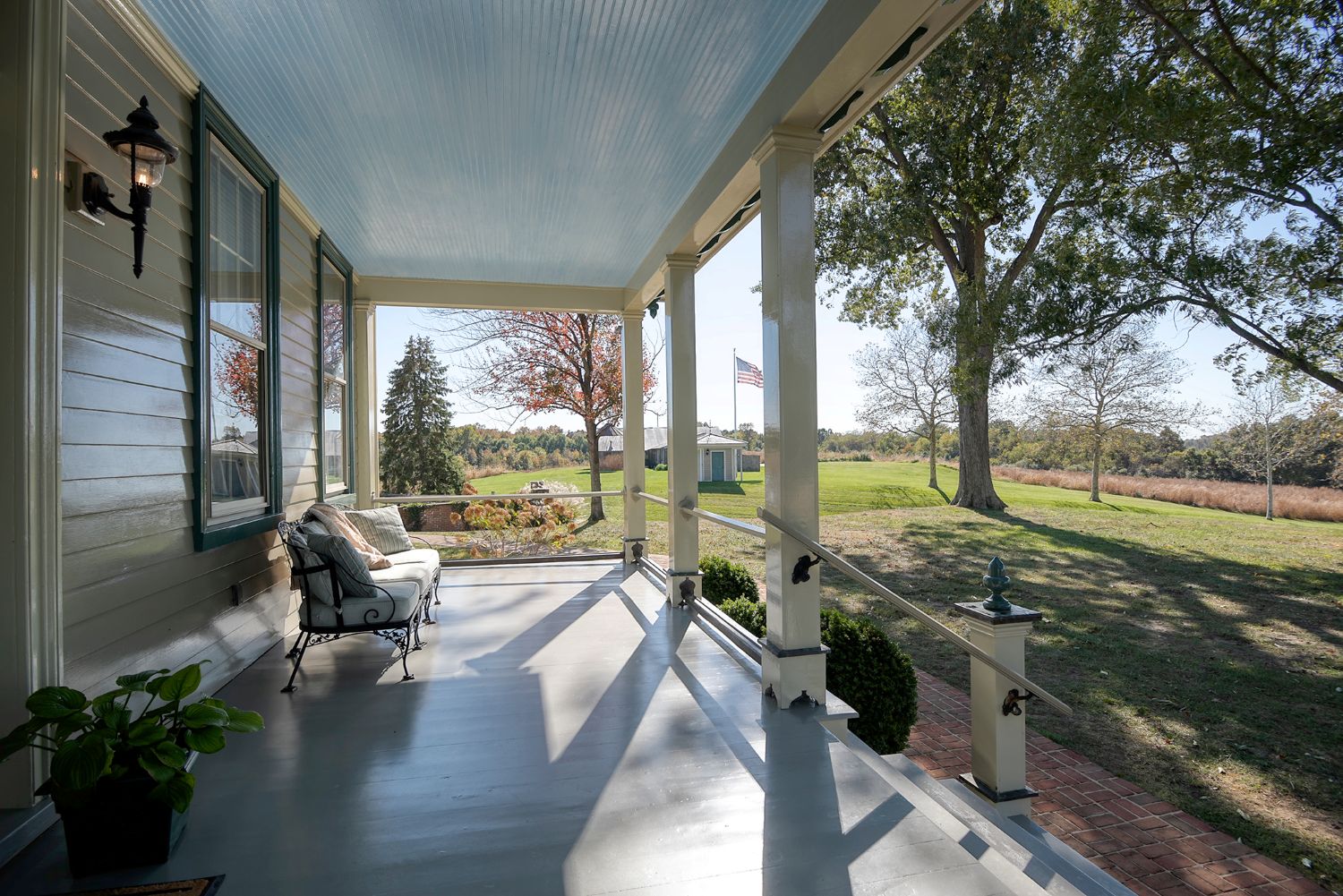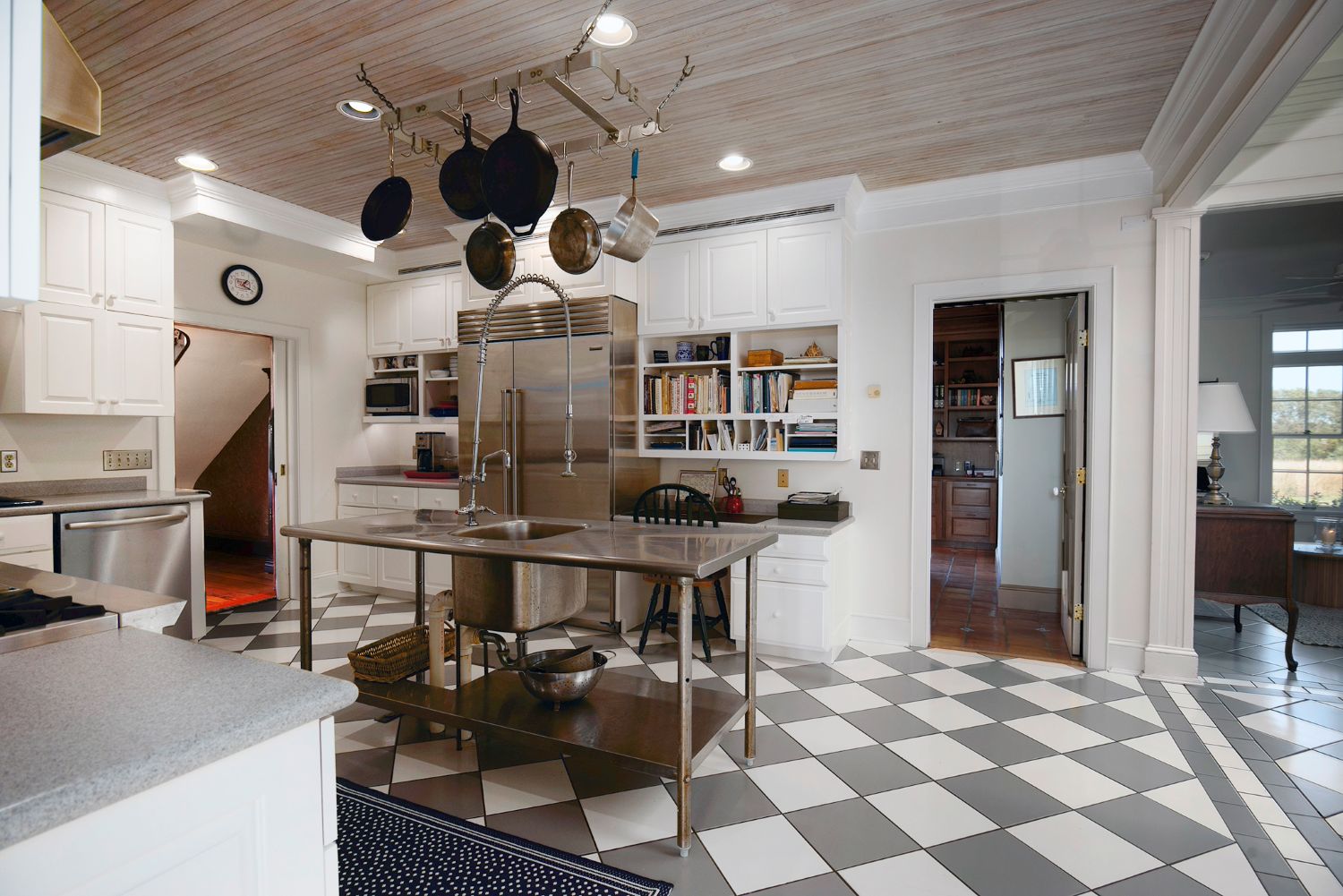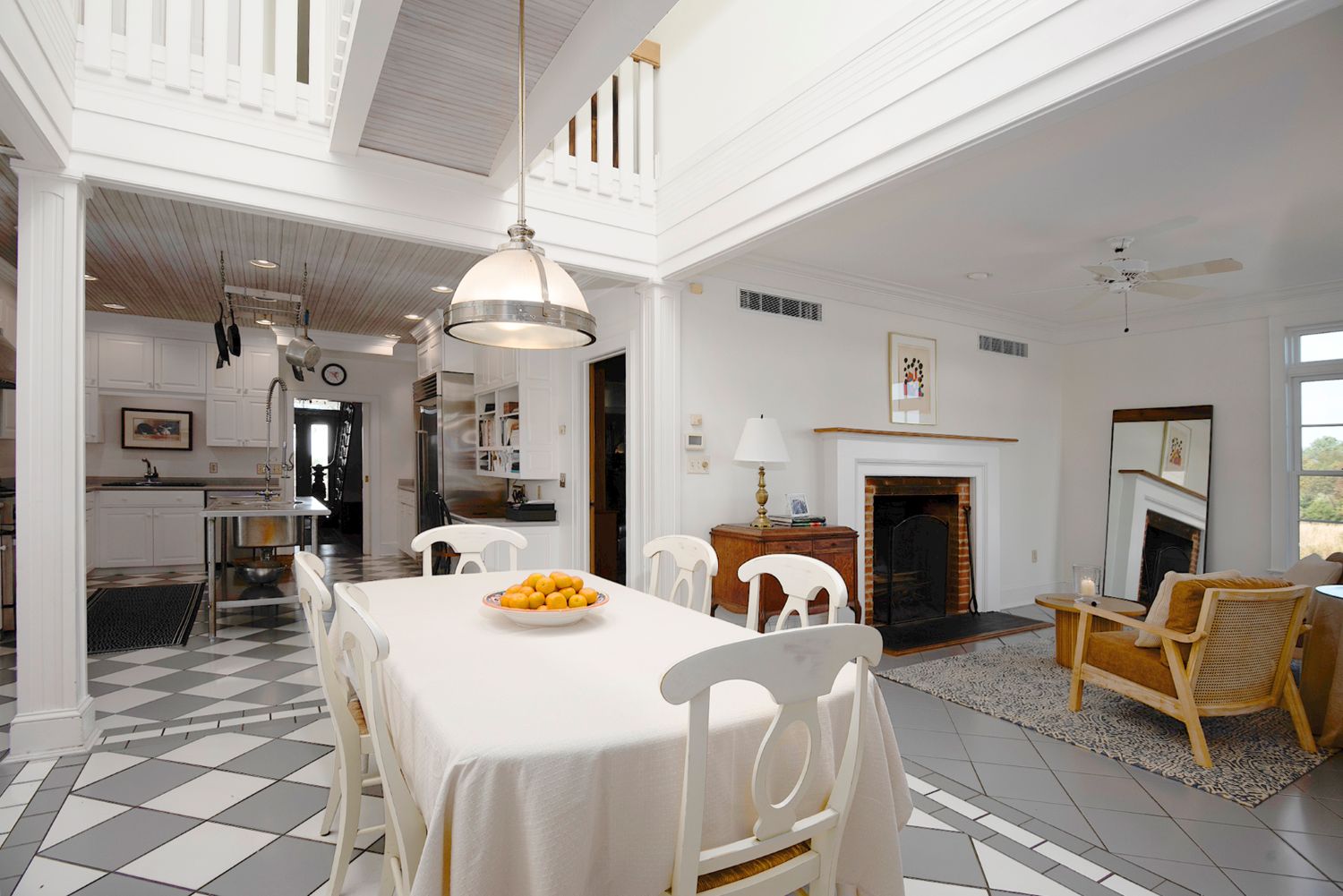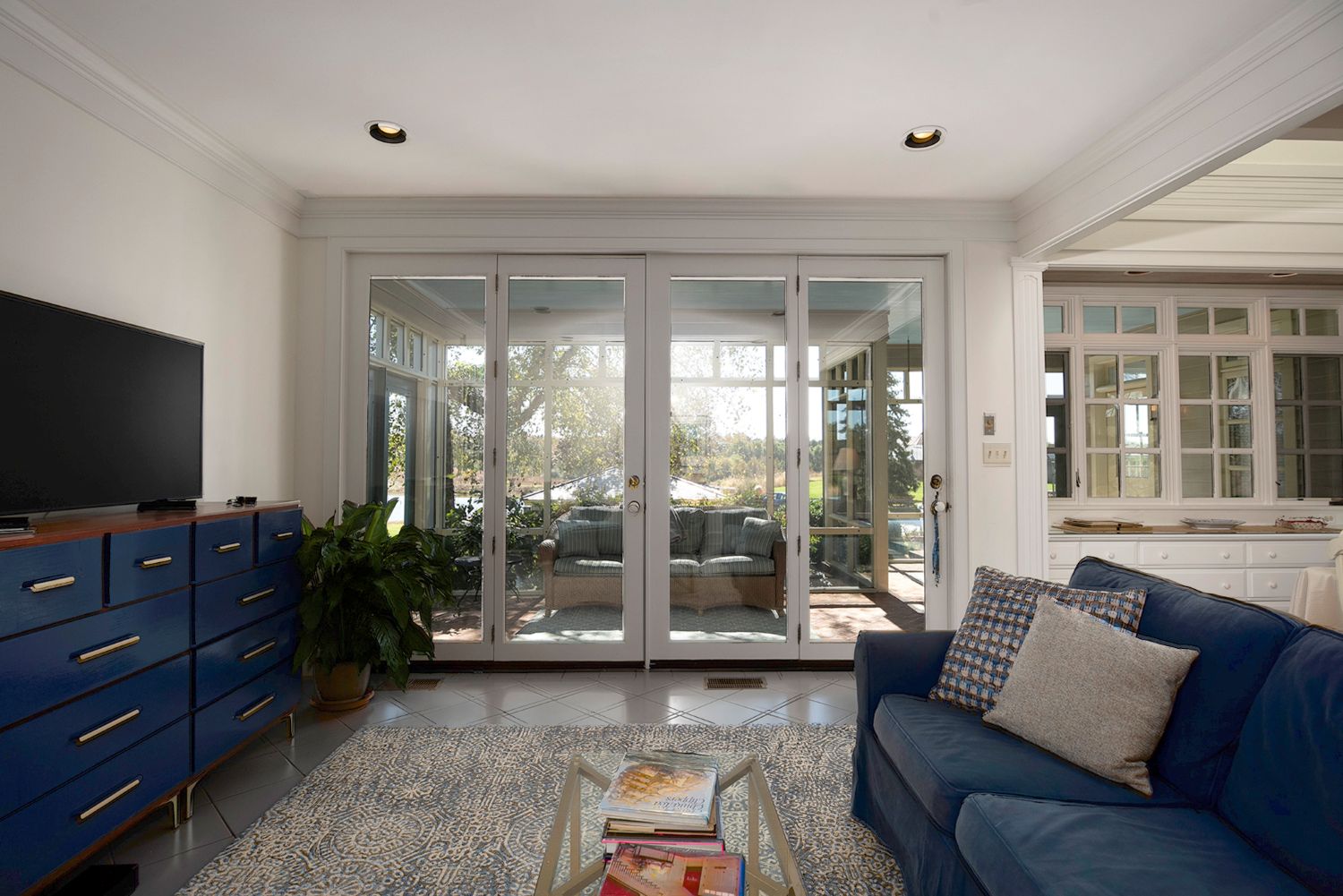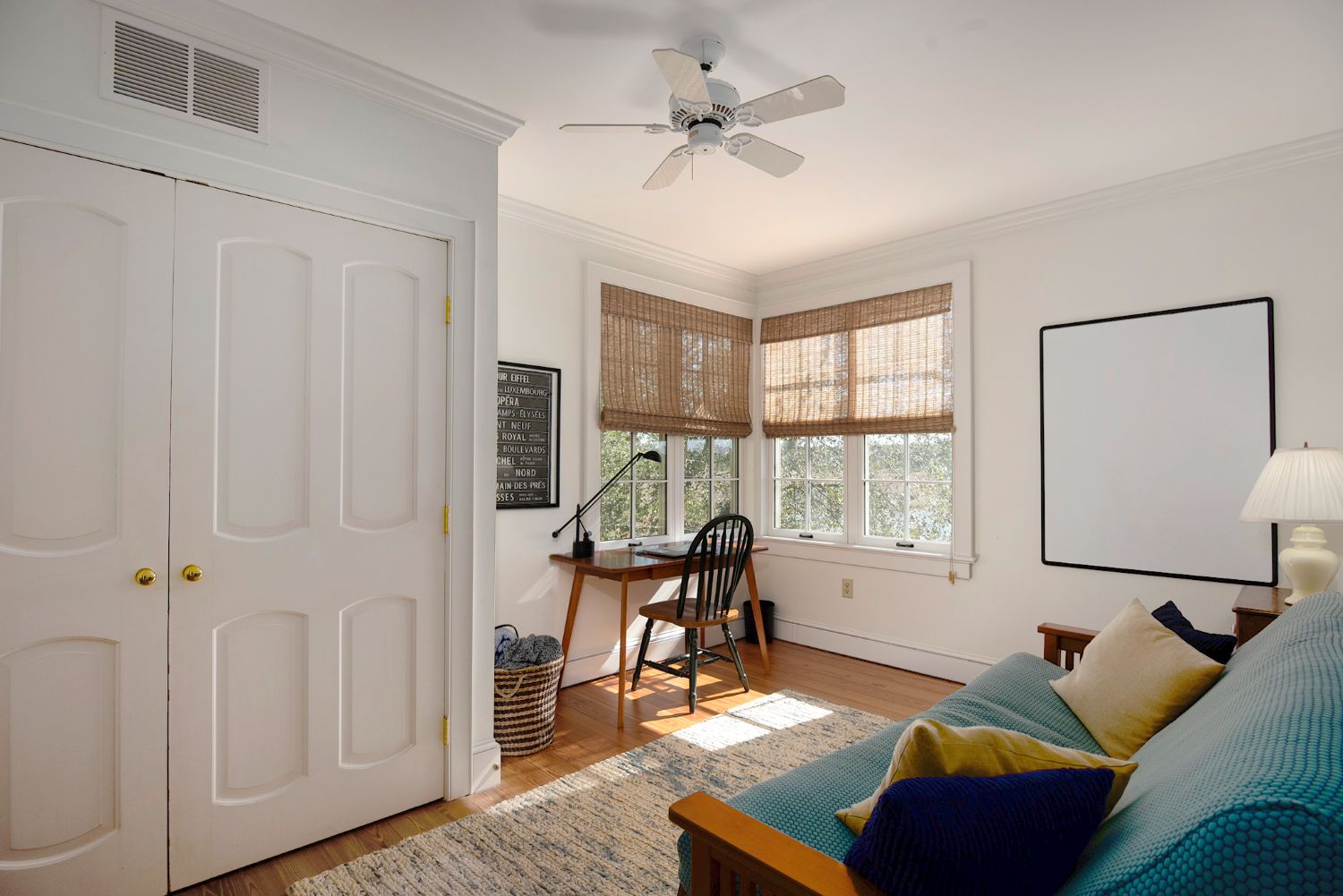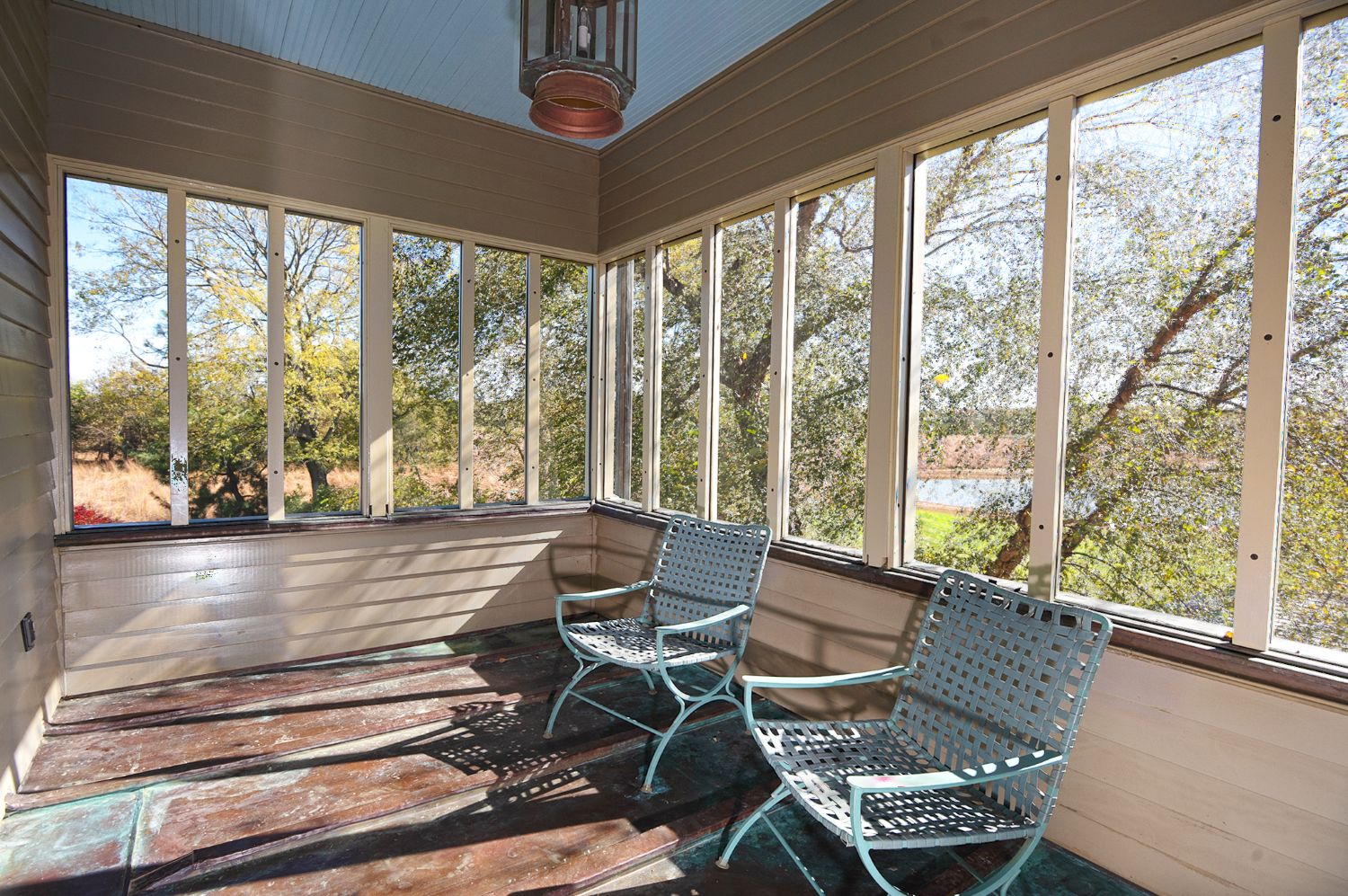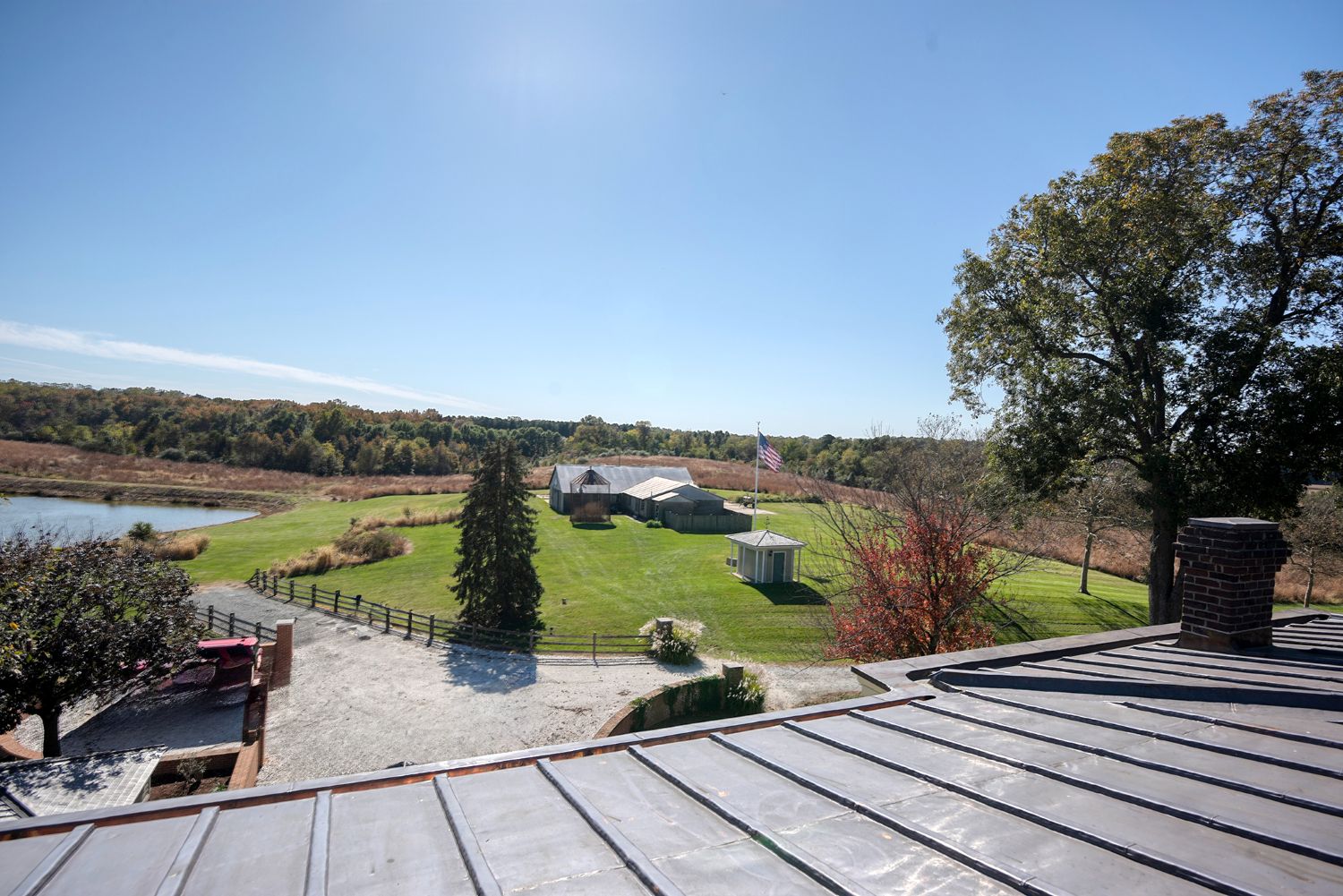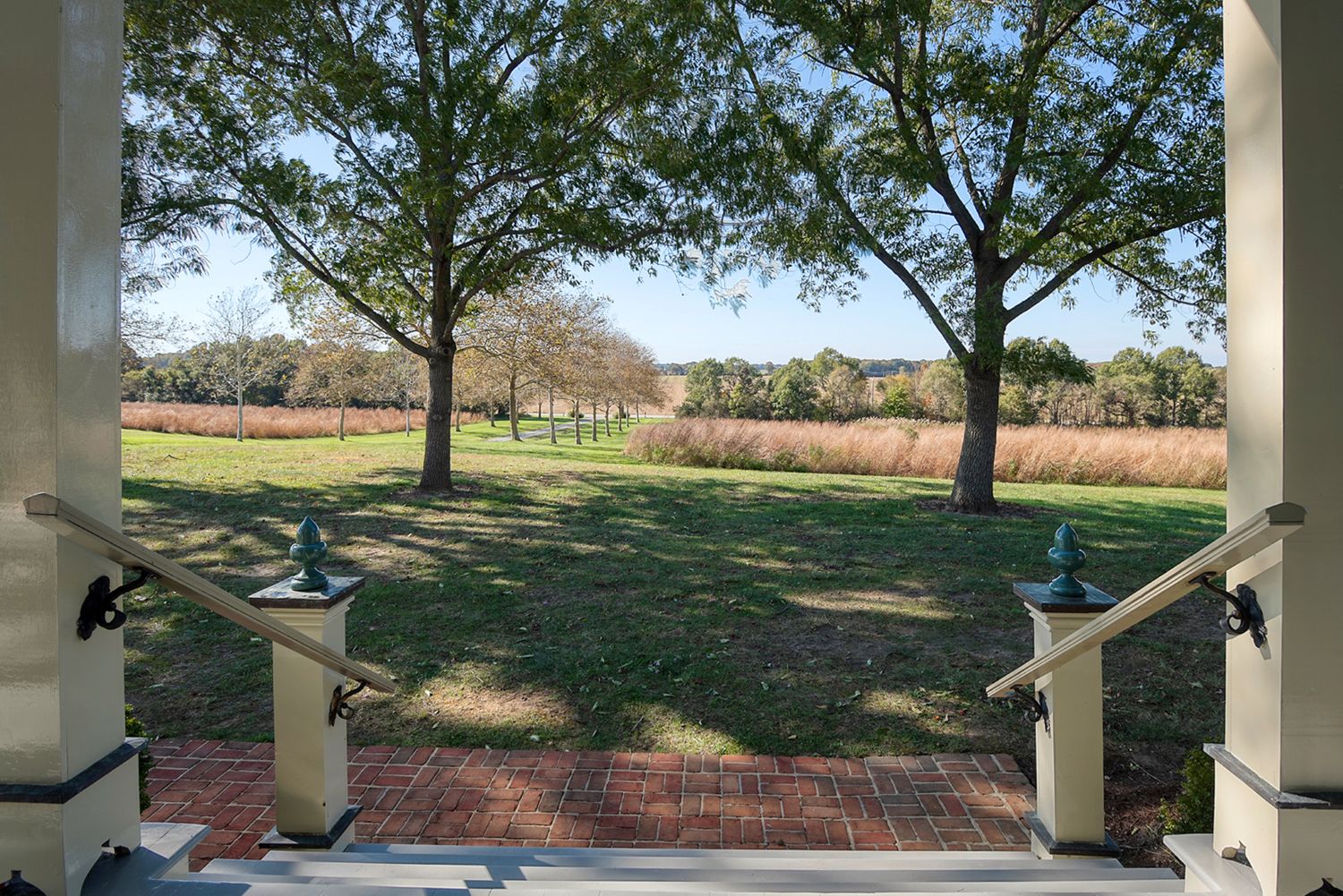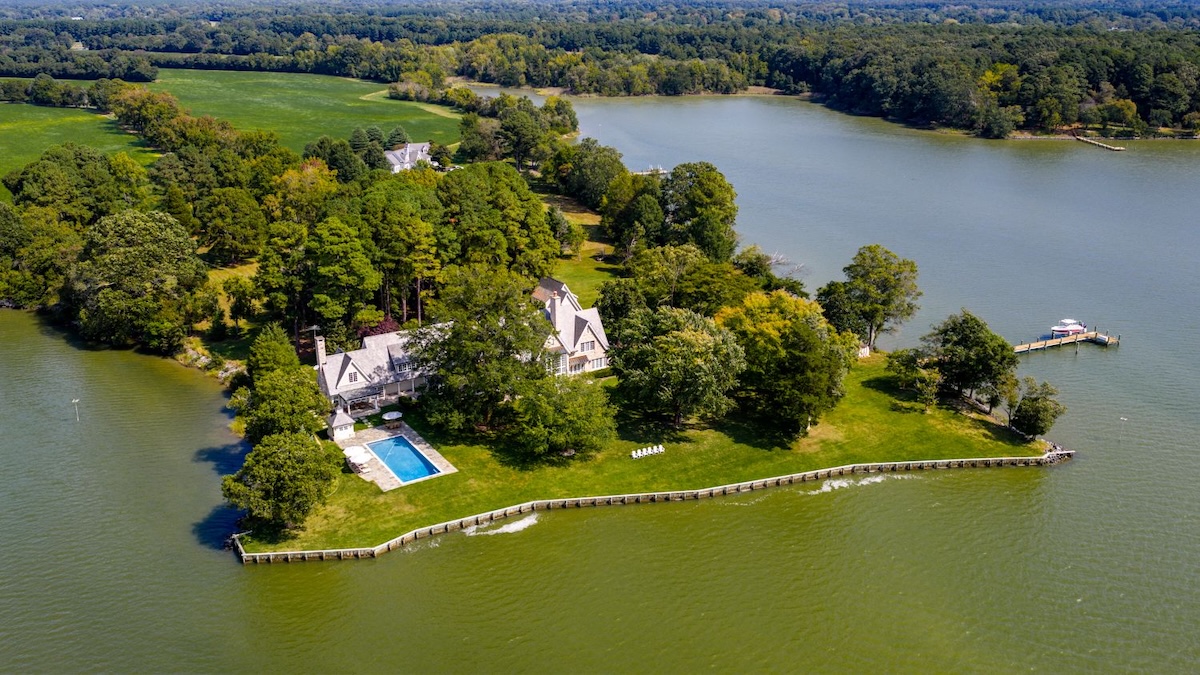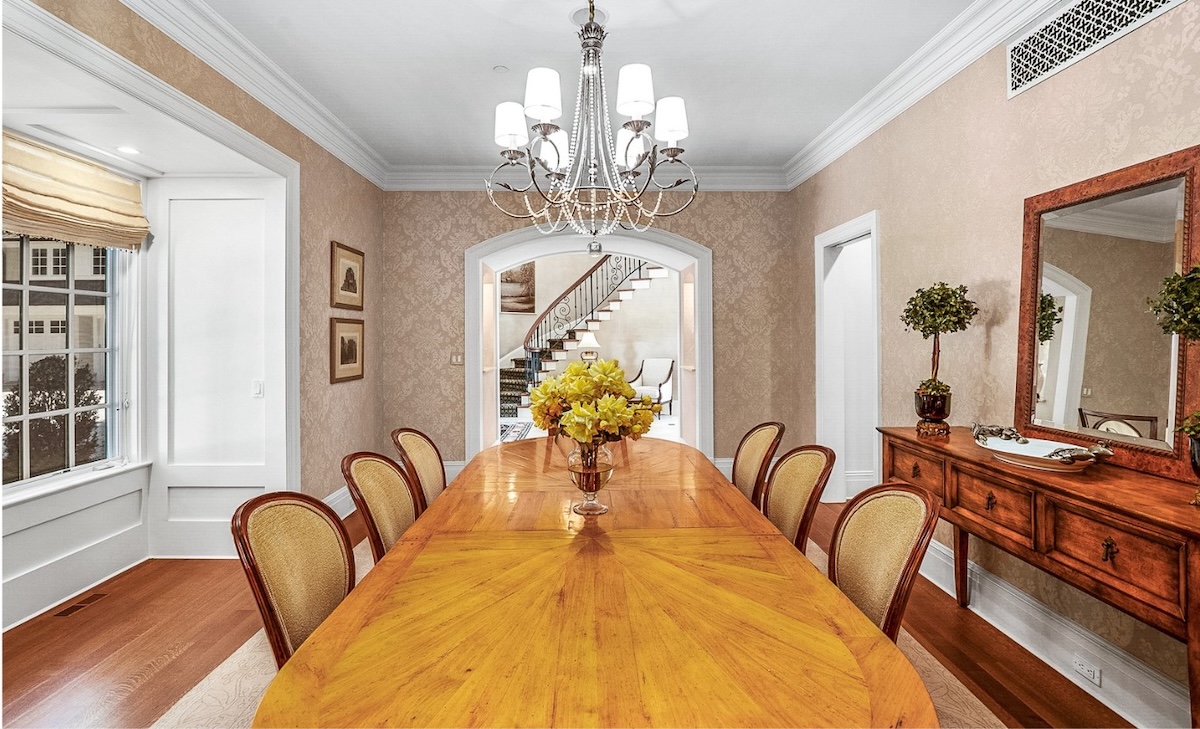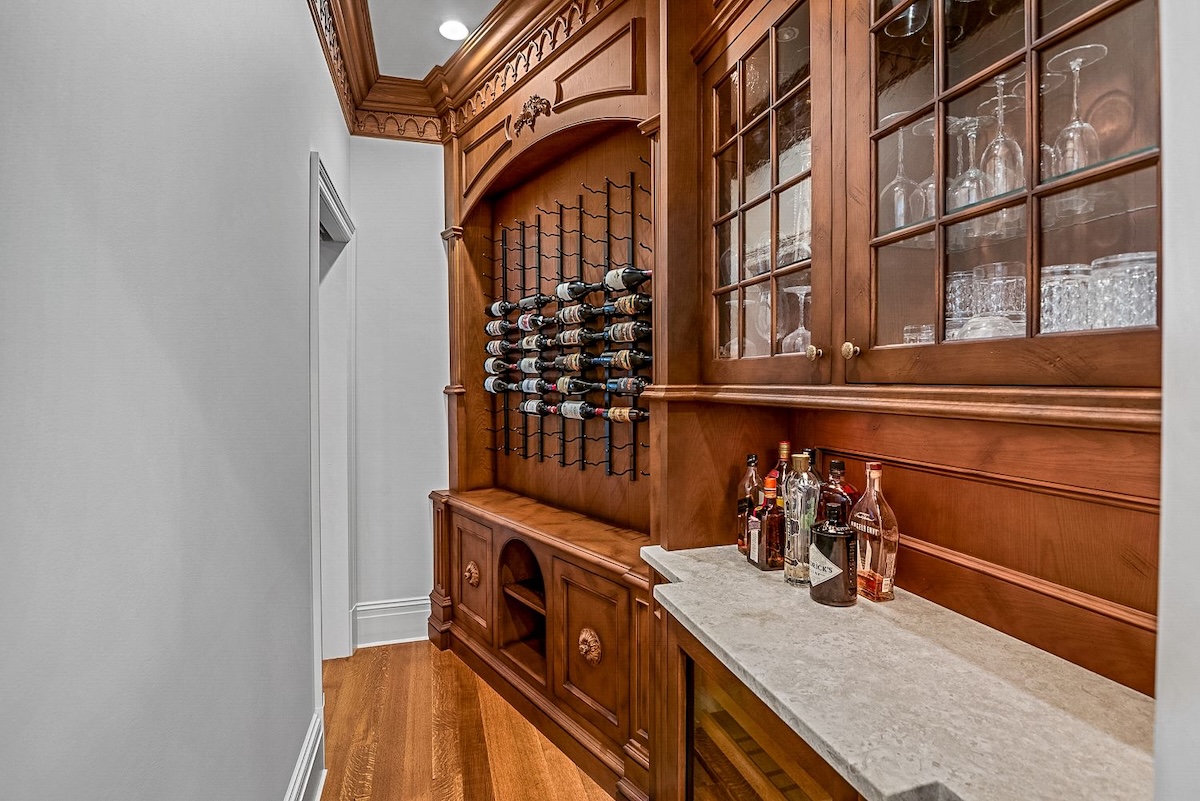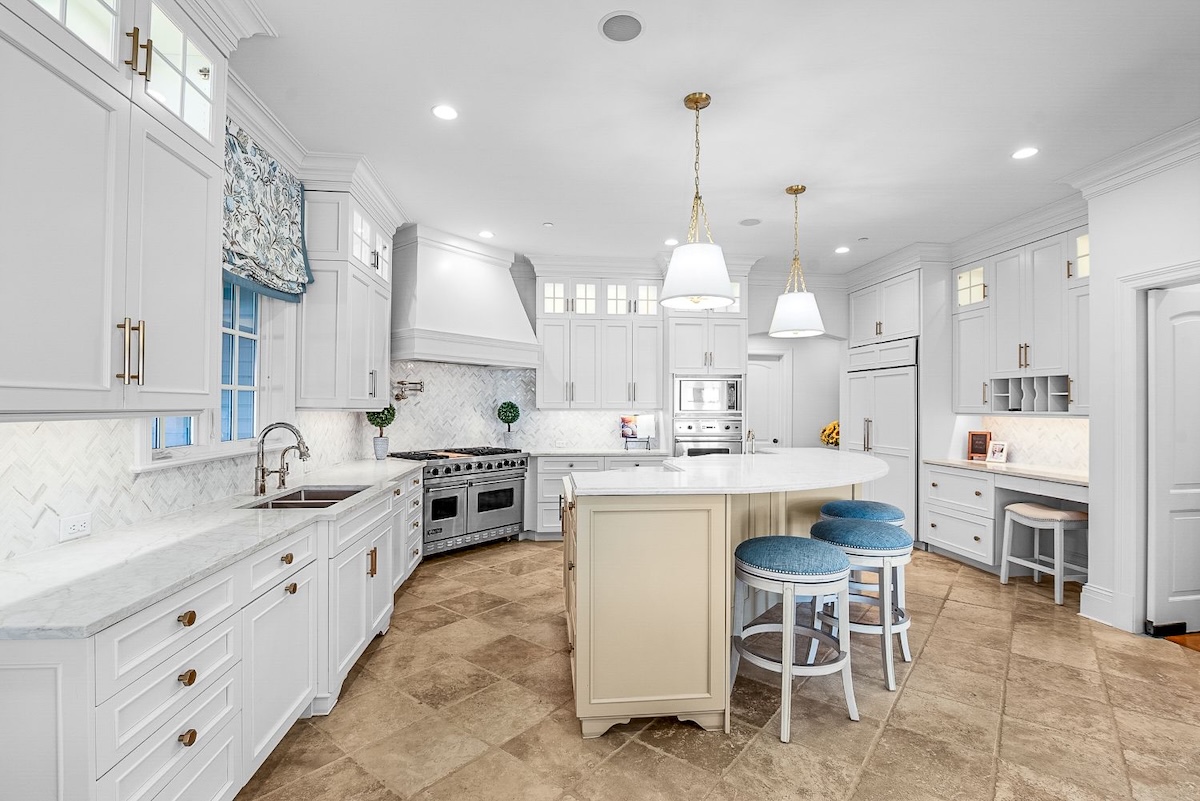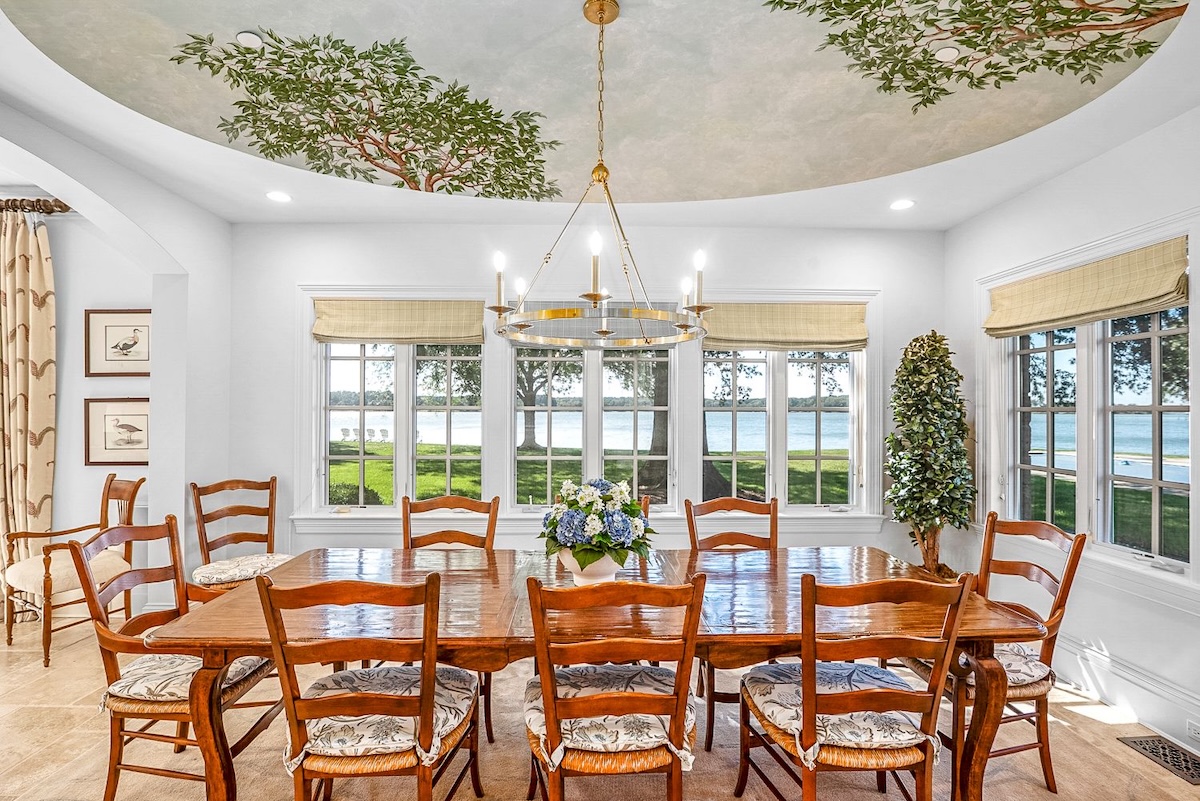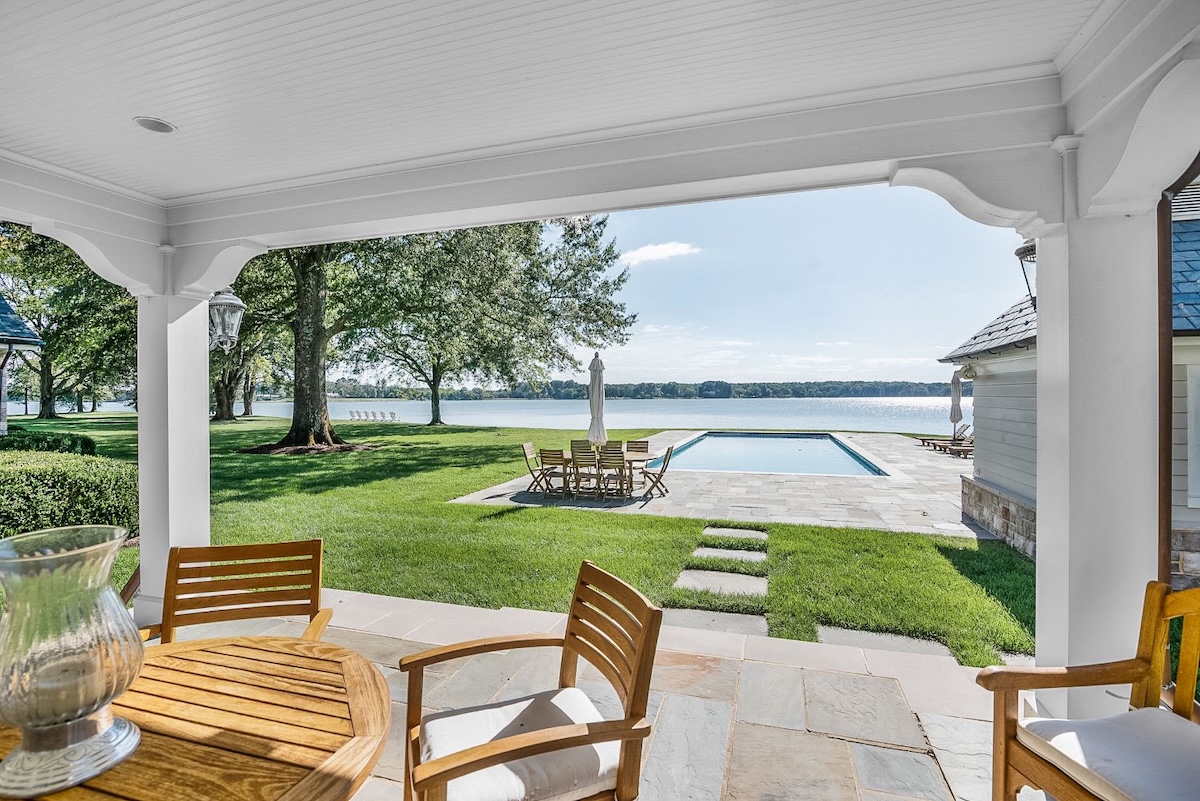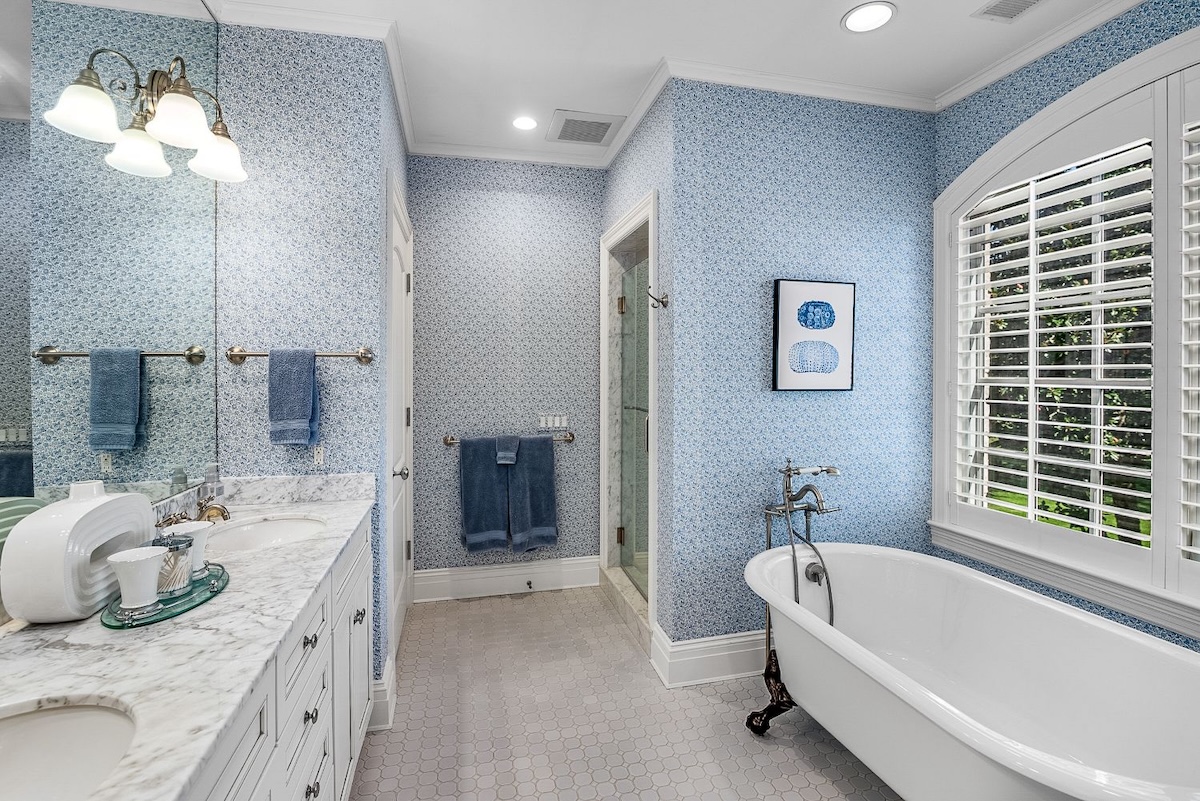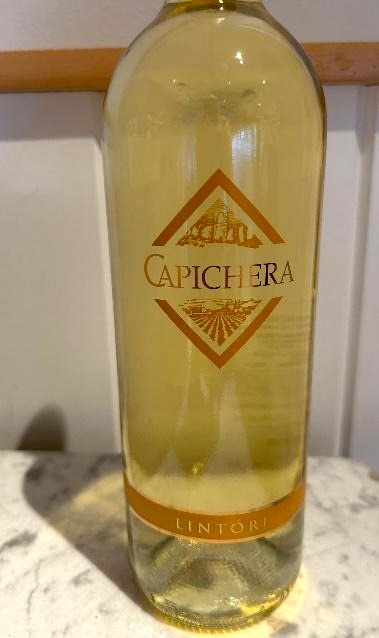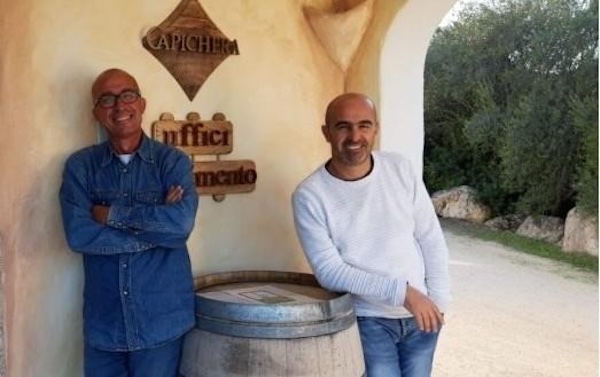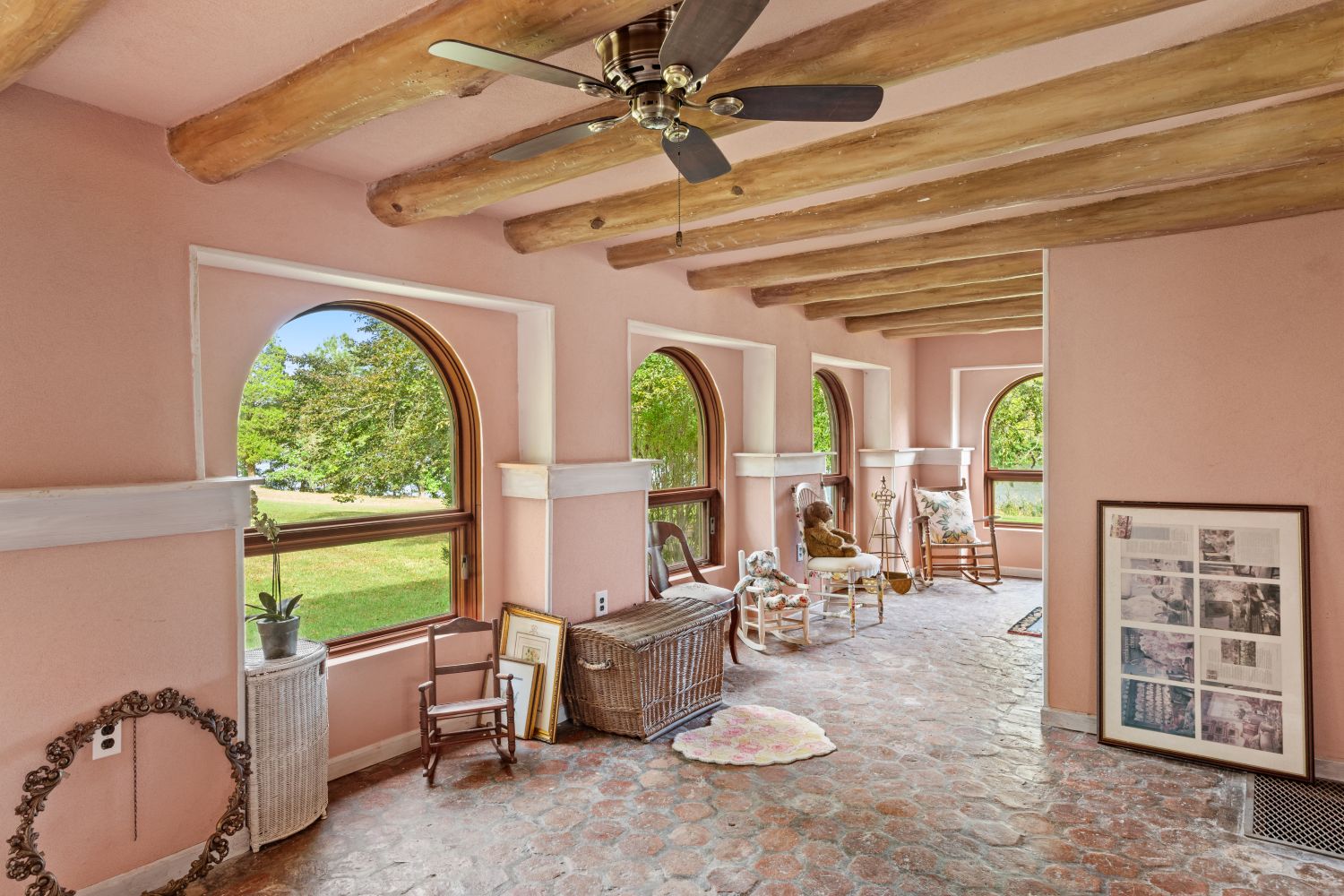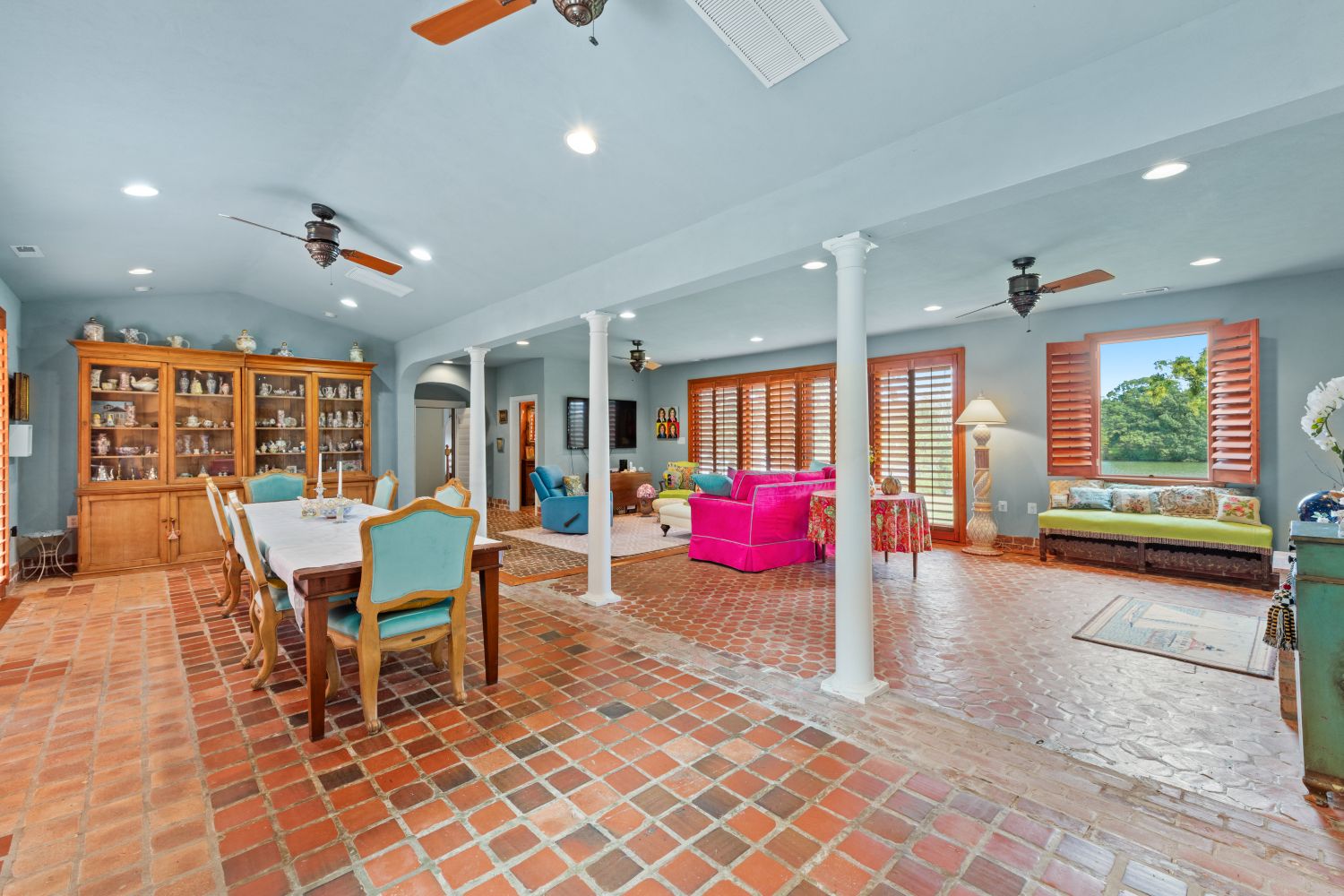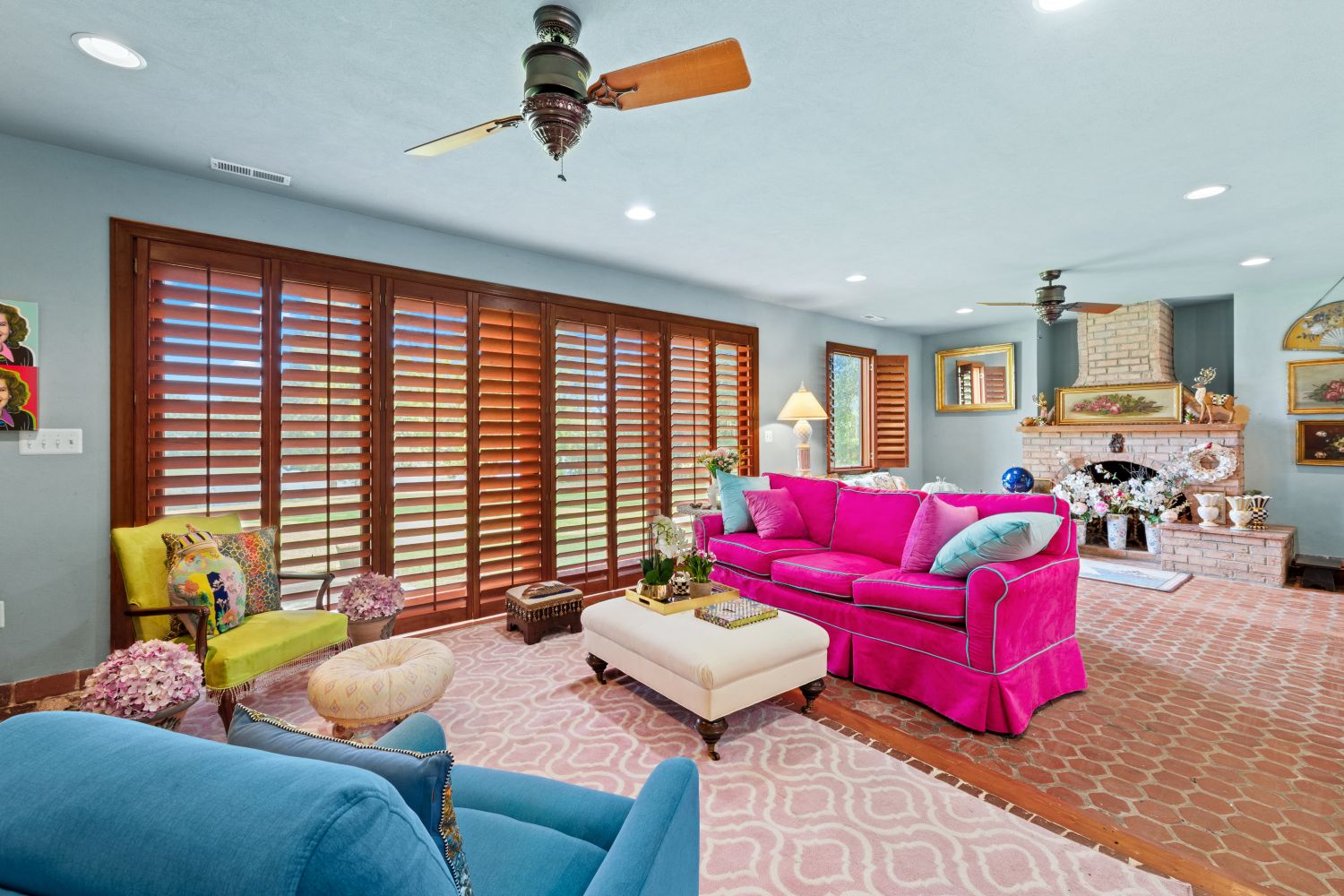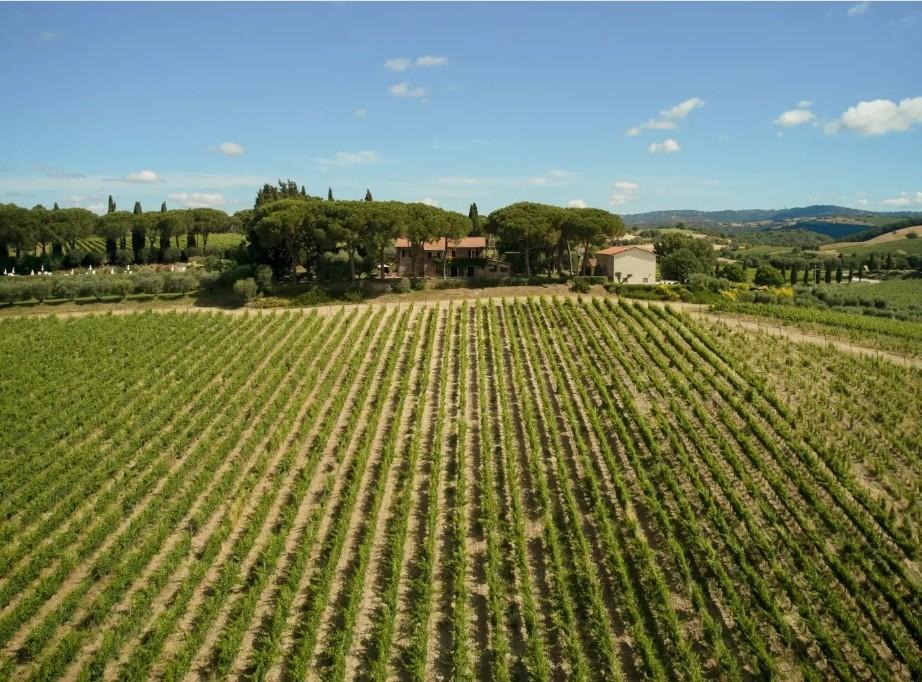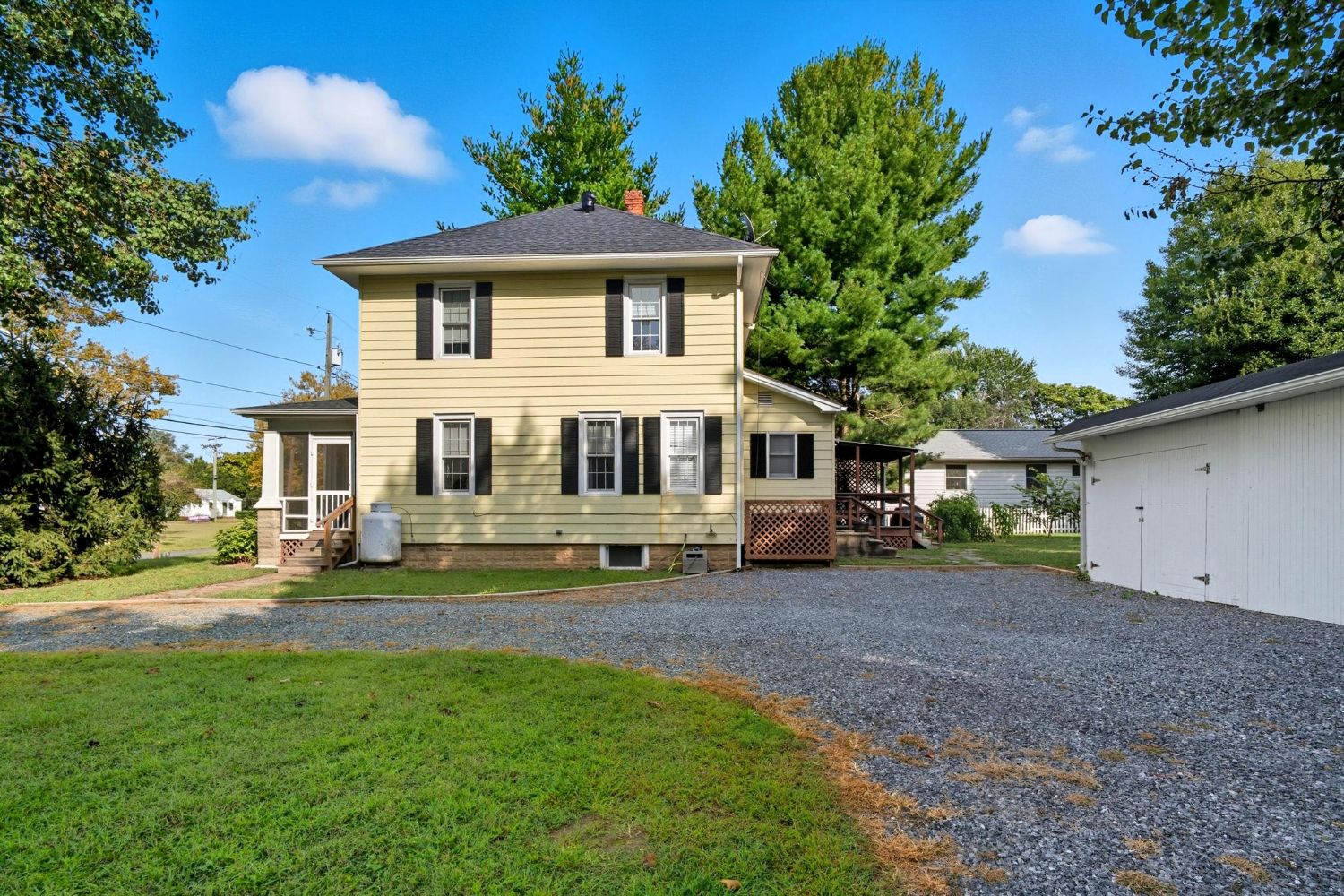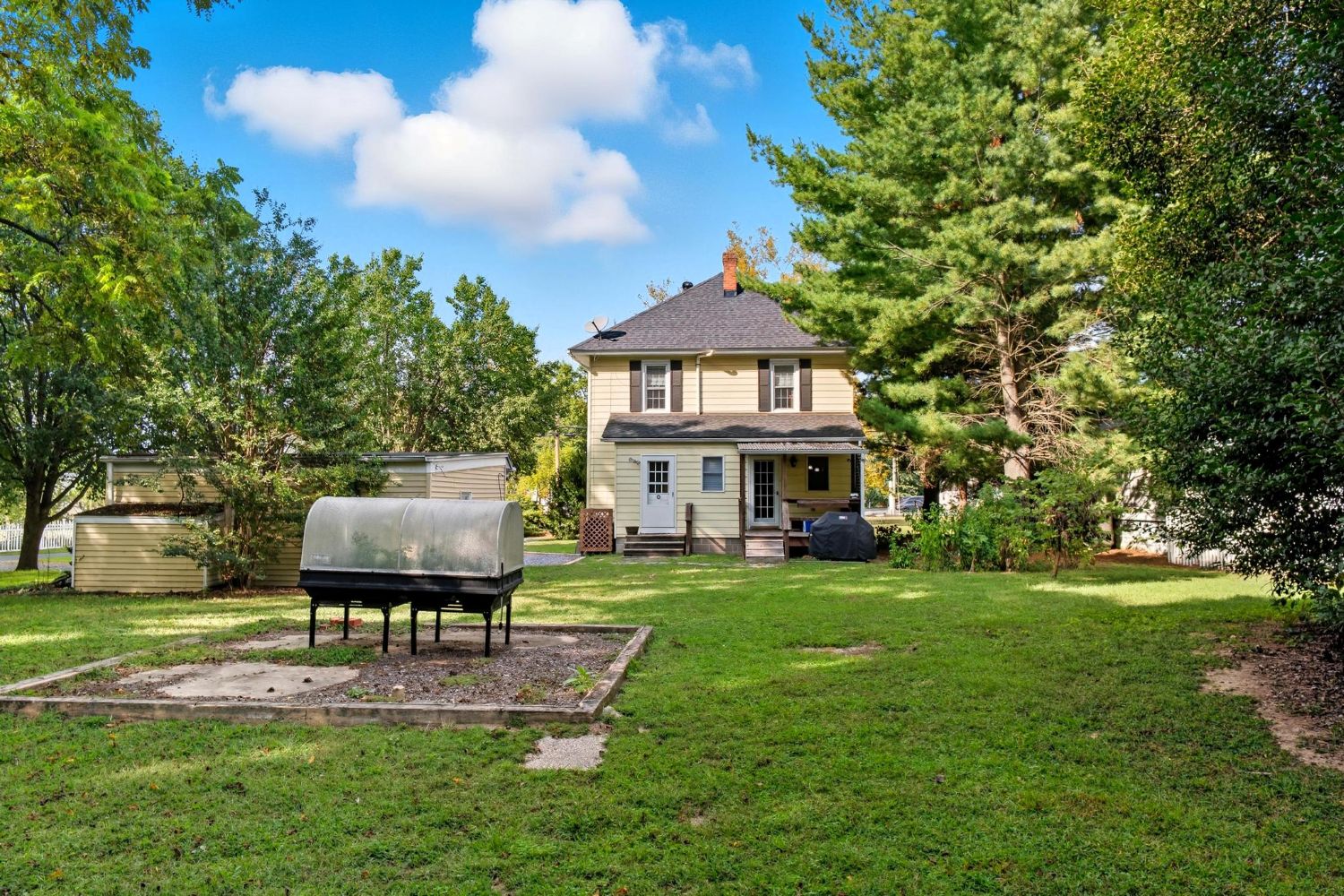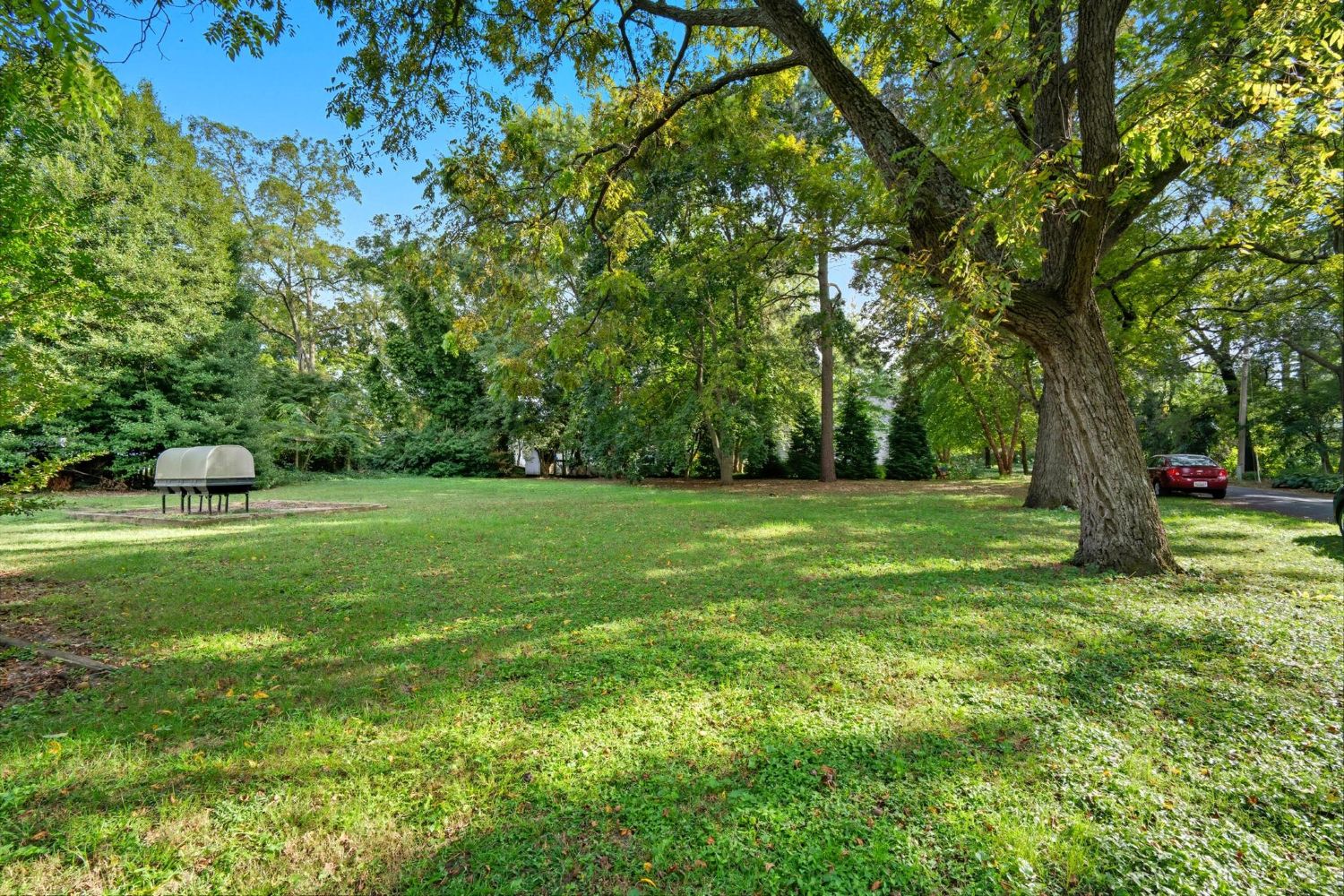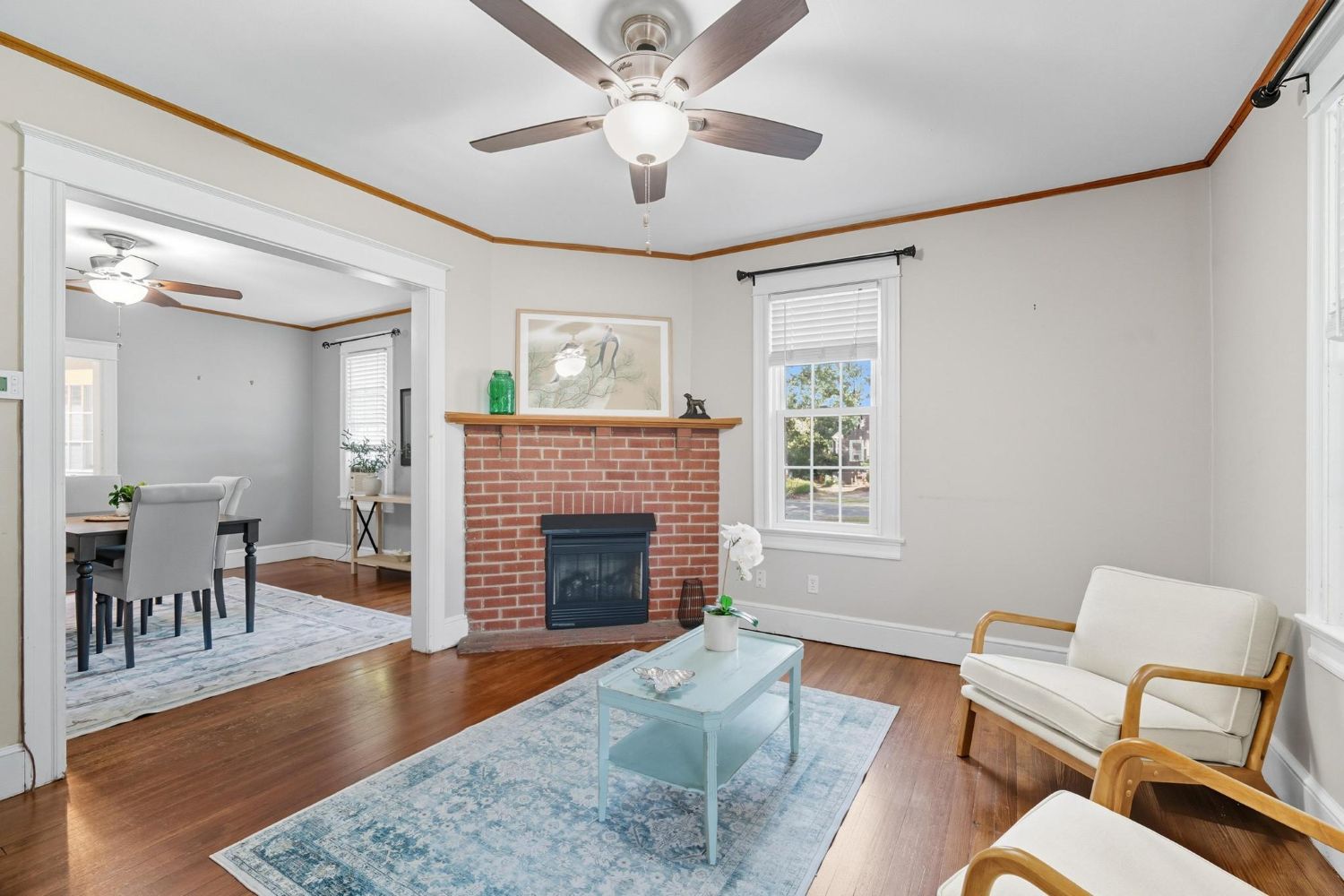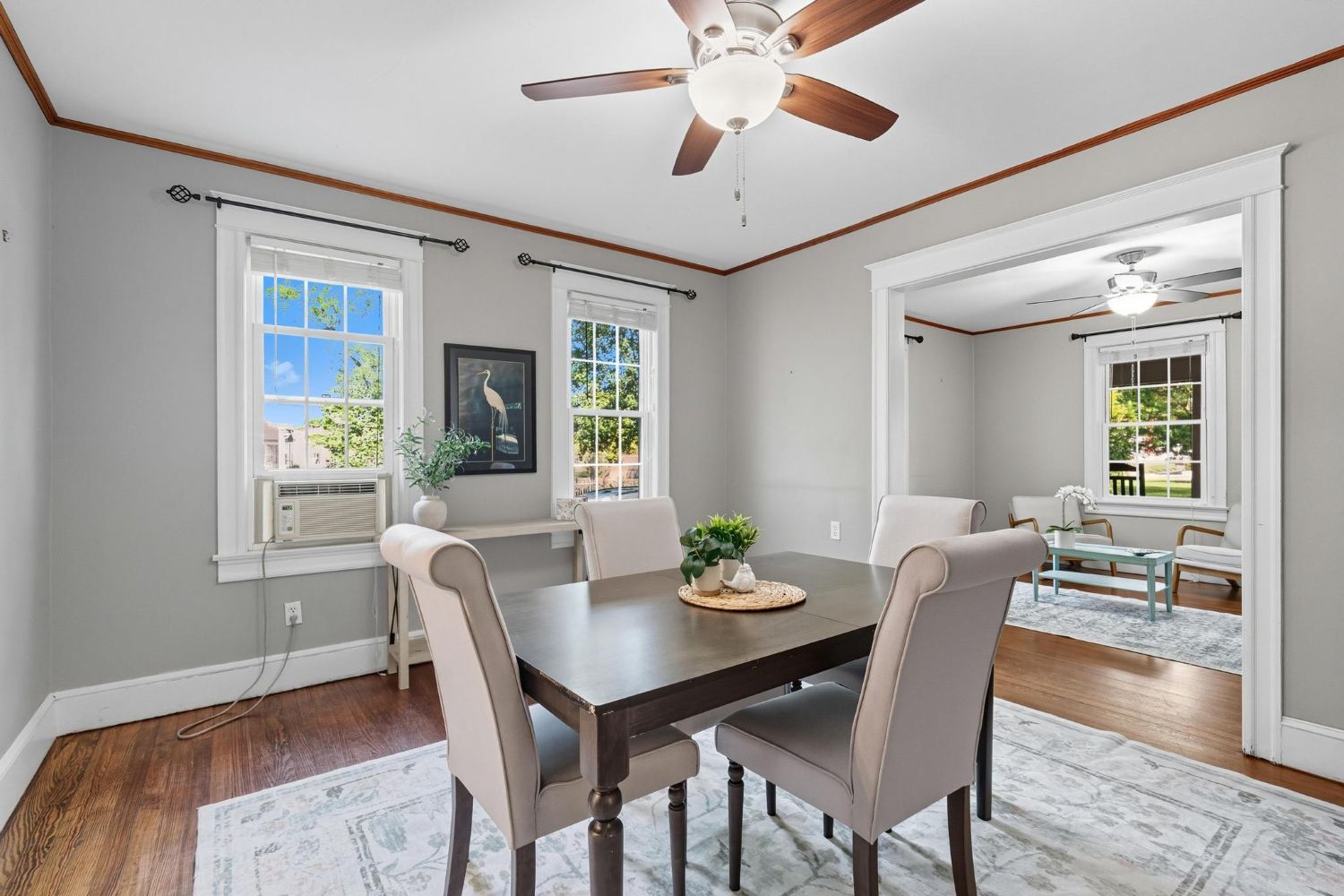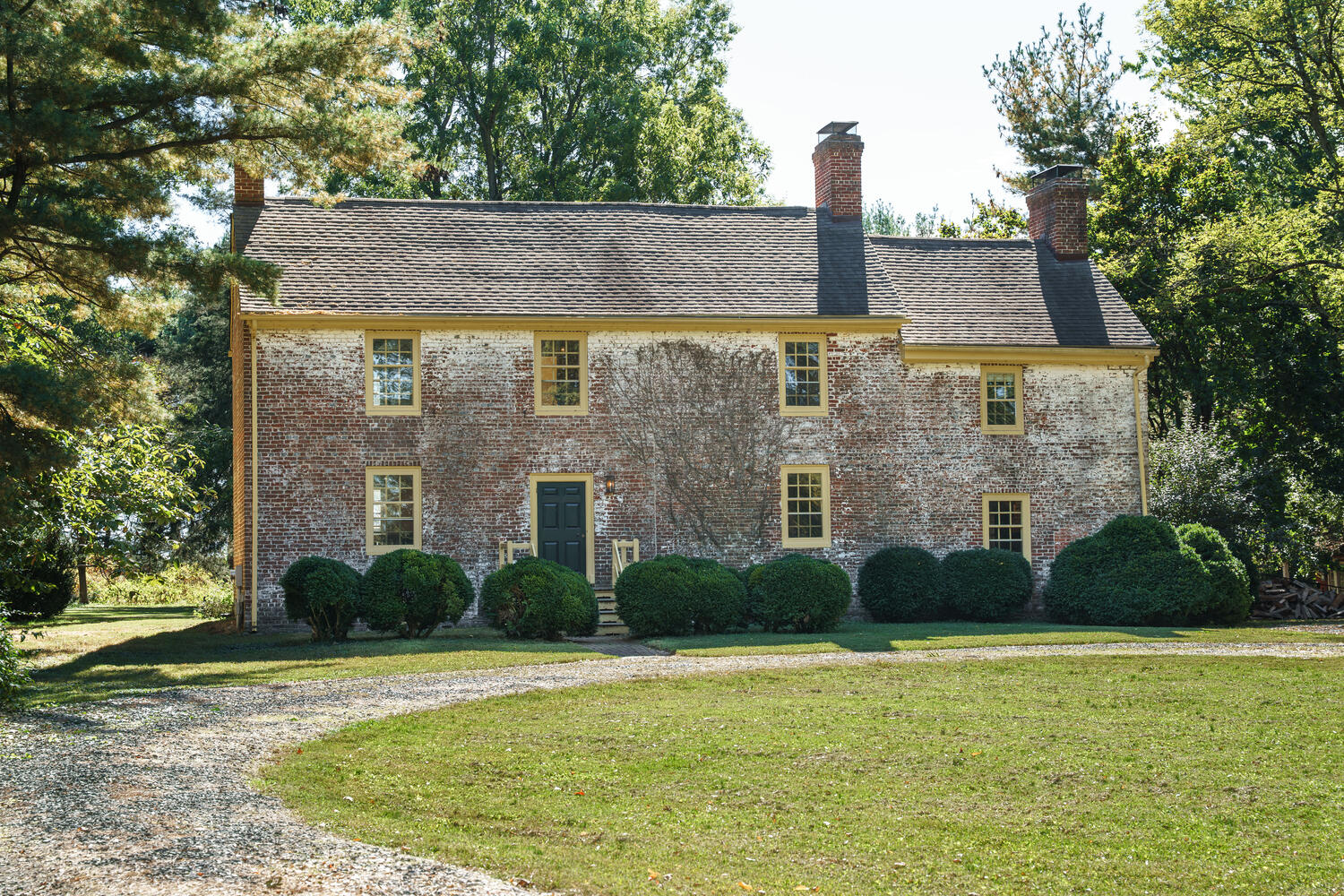
Originally the back of the home, the north façade of “Friendship House,” showcases pristine 18th-century Quaker vernacular architecture.
“Friendship House” is aptly named, for its original owners were members of the Society of Friends, or Quakers. In the mid-17th century, Quakers were encouraged to leave Pennsylvania and claim this part of Maryland for William Penn. in 1695, Pearce Lamb answered the call and built his house, “Lambs Meadow” in the Georgian Colonial style of that time.
Native Americans sold him their finest farmland because Quakers had a reputation of religious tolerance and were also abolitionists. In 1858, one of Pearce Lamb’s descendants, James Lamb Bowers, paid a heavy price for his anti-slavery stance. He and the Free Black Preacher Harriet Tillison had been helping enslaved people escape via a network of other Quakers’ stations along the Underground Railroad. A pro slavery mob tricked James out of his house and tar and feathered him. Then they went to Chestertown and Harriet Tillison suffered the same treatment. The mob ordered the Lambs to leave Maryland and they relocated to Camden, DE, until the end of the Civil War. James’ and Harriet’s valor is illustrated on a tile mural at the Harriet Tubman Museum and Education Center in Cambridge, MD.
The Lamb Family also co-founded and constructed the Cecil Meeting House that was built next door to “Friendship House”. At that time, this area was part of Cecil County. The Pearce Lamb family later subdivided their farmland and several homes were built by their descendants, including this house that was built in 1782 by Daniel Lamb and his wife Harriet Bowers. Historians consider “Friendship House” to be one of the finest example of 18th century Quaker vernacular architecture on the Eastern shore, if not all of Maryland. This north façade was originally the back of the house; the south façade faced a colonial road and that was the main access to the house.

The stoop reflects 1792 expansions, marked by artifacts left by Harriet and Daniel Lamb, blending history with timeless colonial charm.
“Friendship House” began its life as a two story, one-bay kitchen with a dirt floor next to a two-story, one bay living room; each room had a fireplace on the west facing walls. The vertical line on this north side marks the 1792 expansion of the house that added a foyer and living room to create a four-bay, center hall floor plan. The bricks for the house were probably fabricated by brick makers who traveled the countryside seeking work during the time this house was built.
Daniel and Harriet Bowers Lamb left clues about their house’s timeline. The initials “DL” on a date brick was salvaged when the original chimney in the kitchen was reconstructed in 1985. Between two windows in the attic, another brick inscribed with “H DL 1792” for Harriet Bowers and Daniel Lamb was discovered. The last clue was the discovery of “Harriet” signed on one of the ceiling beams of the second floor middle bedroom, by a young daughter named for her ancestor.

Dormers added in 1830 enhance symmetry and light while remnants of whitewashing preserve the home’s layered architectural history.
“Friendship House” endured an 1830 renovation when the next generations of Lambs preferred the Federal architectural style. Dormers were added in the attic to augment the side windows flanking each chimney; the house was whitewashed; layers of lathe and plaster were applied to the ceilings; doors were upgraded from plank to paneled styles; the windows were made taller and shutters were added; fireplace mantels were also updated to the current style.
I prefer the house’s look as it is today because it is in keeping with the earlier Lamb family members wish for their house to embody simplicity, domestic equality and function. I also like how remnants of the whitewashed period remain as they are both part of the house’s life and the facades are more interesting than a monochrome colored brick facade.

The mid-20th-century additions complement the home’s massing, while restorations bring the historic south façade to life.
In the mid 1950’s, the house acquired modern necessities, including electricity and indoor bathrooms. The kitchen’s fireplace and chimney breast were removed for the kitchen’s redesign and a mud room was added at the south facing exterior door. The house entered a new phase of being a rental property for much of the rest of the century.
In 1985, “Friendship House” was fortunate to have new owners, Reverend David LaMotte and his wife Liz, who oversaw the house’s restoration. They enlisted the knowledge, expertise and workmanship of artisans, architectural historians, and experts in restoration to restore “Friendship House to its 18th century appearance; an effort that lasted for many years and the house’s interiors today are the result of their herculean efforts.
As an architect, I especially admired how the massing of the frame additions of the kitchen and the sunroom respect the existing house and the “Chestertown Buff’ color, chosen by the current owners is simply perfect. Prior to selling “Friendship House” in 2007, the LaMottes renovated the kitchen. Unfortunately, the buyer was unable to keep the house up and the house was shuttered for almost ten years. The current owners came to the rescue of “Friendship House” when it was a short sale due to the sorry state of both the grounds and the house. The current owners slightly modified the kitchen but the majority of their focus was to save and update the house for the next steward of this exceptional house.

Pumpkin pine floors and a black walnut staircase reflect the home’s commitment to beauty and Quaker simplicity.
On the day of my tour with the Listing Agent, one of the Owners graciously joined us; due to his being an architectural historian, I could not have asked for a better guide. I am indebted to his passion about “Friendship House” and for sharing his research material with me. I admired the beautiful wood floors that I learned were yellow pine, sometimes referred to as “pumpkin pine ” because of the lovely color it turns into as it ages. I also discovered he and I share a passion for the Arts & Crafts movement, when I saw the exquisite umbrella stand in the corner of the stair hall.
Both the front and rear doors align with each other for symmetry, ventilation and for vistas to the landscape from each door. Wide doorways lead from the stair hall to both the living and dining rooms. I admired the black walnut stair and its simple design in keeping with the simplicity of Quaker interiors.
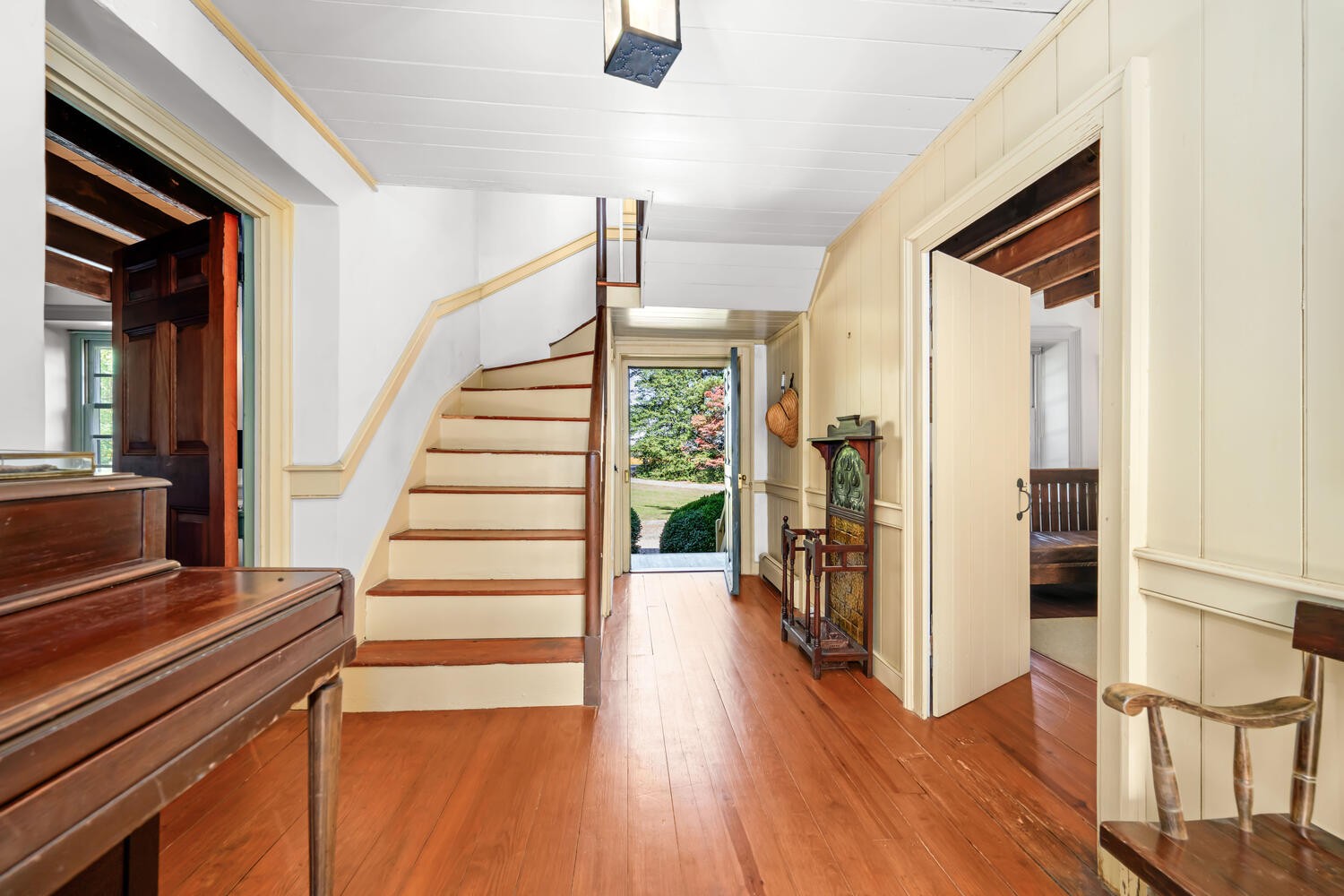
Textures of paneled wood walls and ceilings highlight craftsmanship alongside the understated geometry of the stair design.
Before exploring the living and dining rooms, I walked past the wide doorways to both rooms to admire the simple geometry of the stair as it winds its way to the second floor as the Owner pointed out the pegs at the top of the stair’s newel post. I also admired the texture of the wood paneled walls and ceiling that is so much more interesting than an expanse of drywall.

The hand-hewn Linden wood joists and Stickley settee enrich this historic room rooted in Tidewater traditions.
Like other Tidewater houses of the late 18th century, a thin wood wall separates the stair hall from the living room. The Owner pointed out the ceiling/second floor joists that were hand hewn from Linden wood, a species known for its long and clear grain. The Quakers added their signature beaded edge to the side edges of each joist as the joists were never expected to be covered. I coveted the Owner’s Stickley settee, which he discovered at the Crumpton auction near Chestertown.

Exposed ceiling beams complement bespoke millwork around the fireplace, creating a space for quiet evenings and music.
Bespoke millwork flanks the working fireplace and the rhythm of the exposed ceiling’s stained beams creates charming interior architecture for one to read by the fire or listen to someone playing the grand piano.
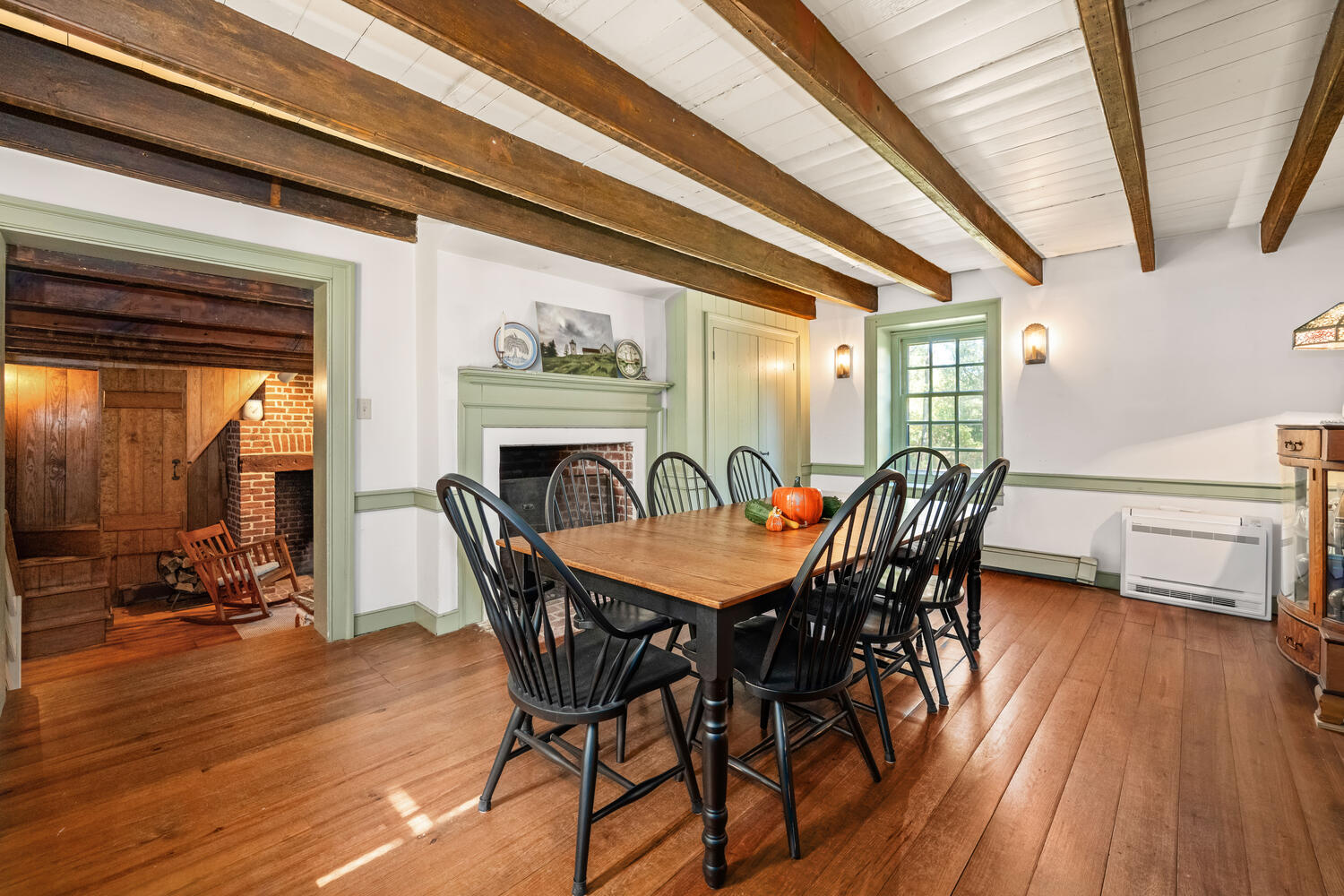
Wide doorways reflect Quaker egalitarian values, while custom tin sconces and paneled elements honor 18th-century design.
As I passed through the wide doorway into the dining room, the Listing Agent pointed out another historic clue, the patch in the SE corner of the room. This patch covered up the stair to the original second floor. Unlike most houses of this period that had a clear distinction between the dining room and the kitchen, the wide doorway to the kitchen reflected the Quakers’ belief in everyone participating in daily domestic tasks that was key to their integrated and egalitarian lifestyle. The simple interior design of the paneled mantel and adjacent cupboard were installed during the 1985 restoration by the LaMottes, after much research to find the best example for “Friendship House”. Custom tin sconces by John Ramsey’s Deep Landing Workshop in Chestertown are the finishing touches.

Reconstructed fireplace features hand-hewn walnut mantel and brick remnants from the 1782 structure, preserving its historic essence.
Steps leading down from the dining room to the former kitchen give the family room extra ceiling height. The kitchen probably had a dirt floor and the owners did not find any evidence to the contrary in the 1985 renovation/restoration of this room. Its historic focal points are the fireplace, chimney and steep stair that are all conjectured reconstructions. Amazingly, the original bricks that had been discarded during the 1955 renovation were found in the wooded dell at the rear of the property, including the 1782 date brick, which now has a pride of place in the side of the chimney next to the bespoke millwork. A black walnut tree that was removed during the 1985 restoration and the construction of the kitchen and sunroom additions, now lives on as the fireplace’s mantel, proudly showing her hand hewn marks. I could easily be quite content sitting on the simple rocker by the fire in this exquisite room so filled with history!
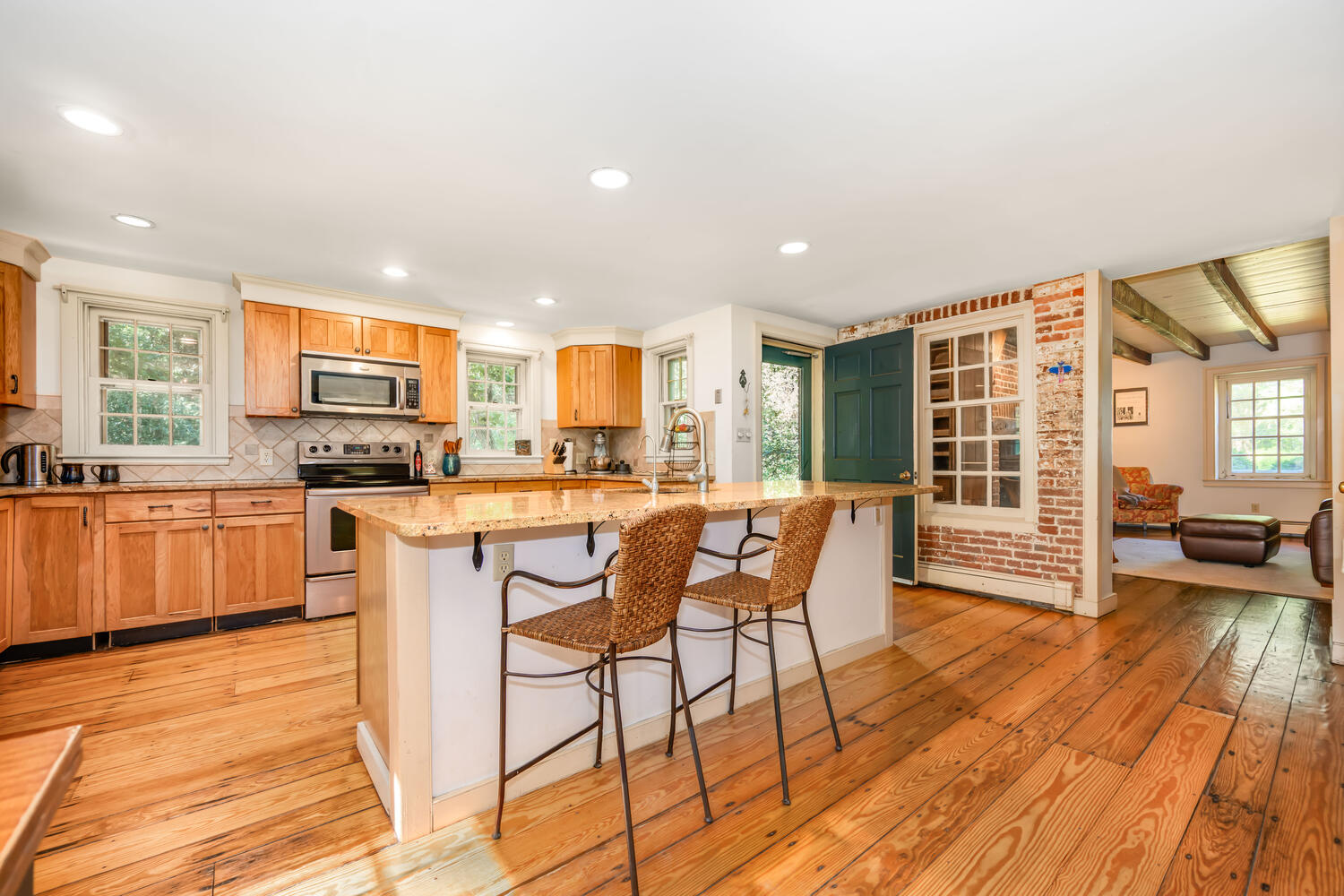
Craftsman cabinetry, granite countertops, and wide pine flooring anchor this updated kitchen in the home’s colonial history.
The addition of the spacious kitchen was designed for today’s lifestyle with an “L” and island arrangement. The exposed brick and window in the original exterior wall of the house grounds it to the history of “Friendship House”. The flooring of wide pine planks could easily be thought of as original to the house. I am quite partial to the simplicity of Craftsman style cabinets and they are befitting for a Quaker house too. The warmth of the wood cabinetry and the granite countertops that complement the color of the cabinet doors make the kitchen the hub of the house where everyone wants to be.
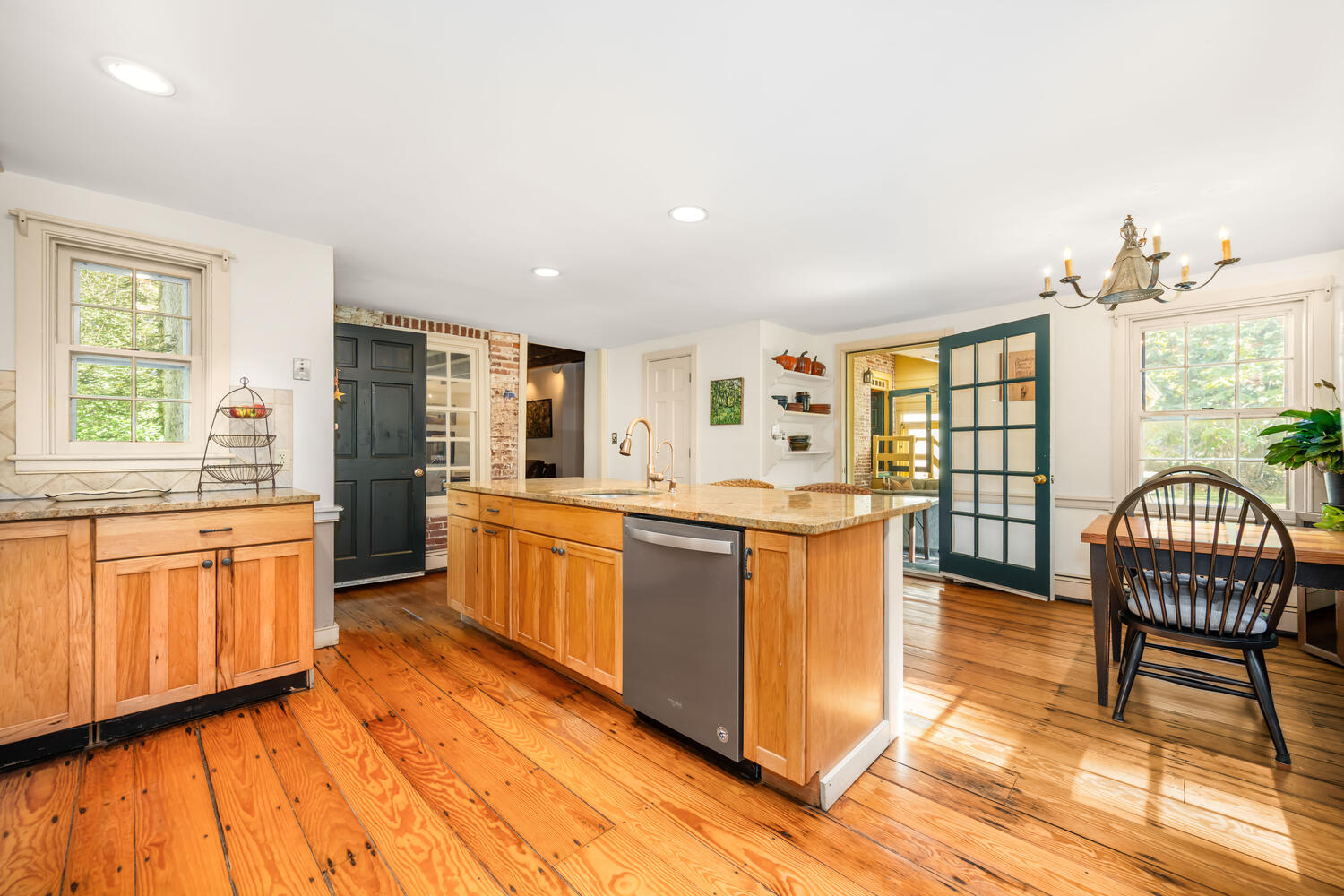
The repositioned sink and island promote modern flow, while wide counters offer space for casual dining and entertaining.
The current owners modified the kitchen layout slightly and one of their changes was to relocate the sink and dishwasher to the island. Now the cook is in center of the action and the island is a great buffet for entertaining or for perching on the bar stools to catch up on emails.
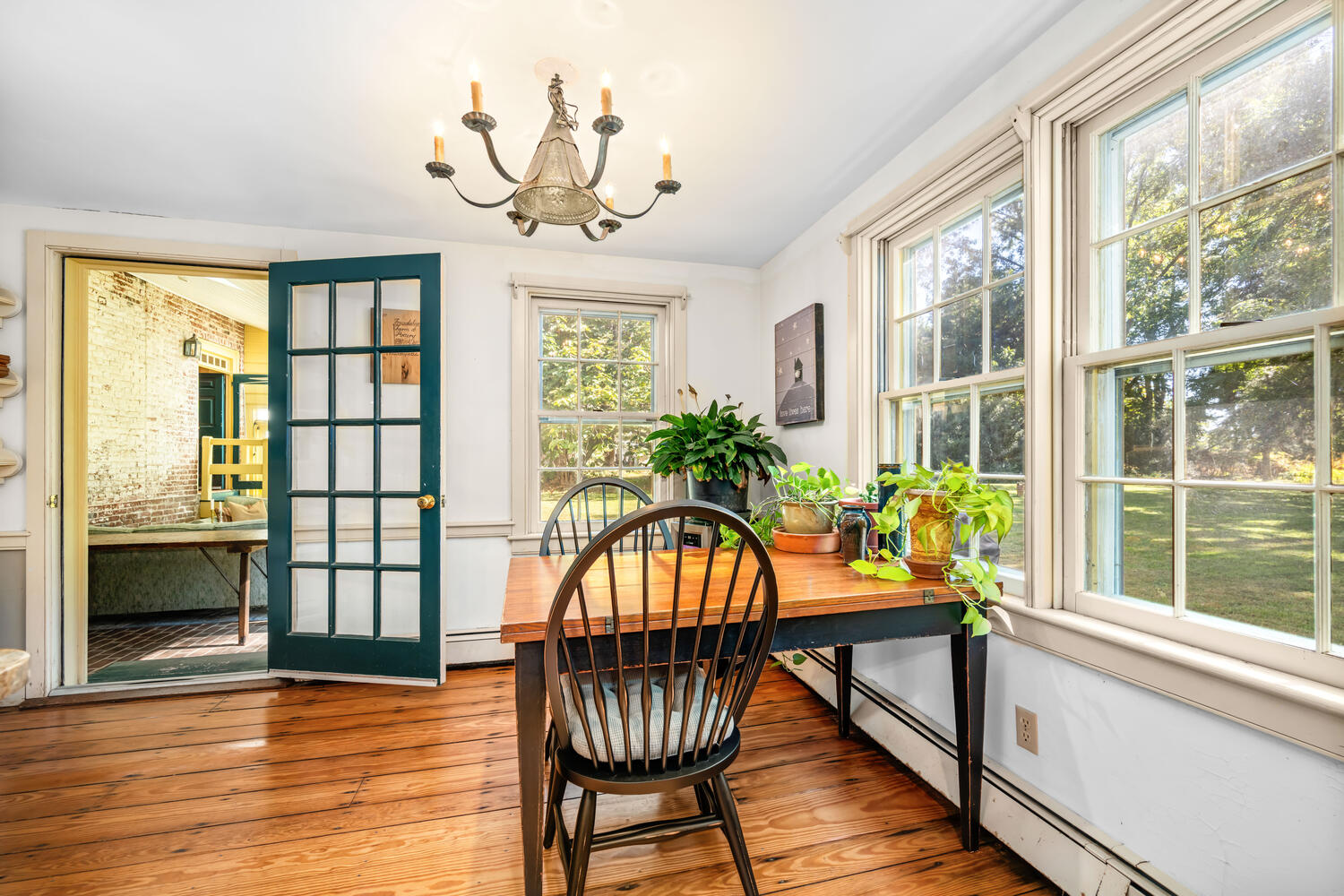
Bright windows and tapered table legs mirror the simplicity of Quaker design in this cozy breakfast nook.
The corner of the kitchen is a delightful dining space for breakfast or informal meals. Daylight steams in from the south and west windows for panoramic views of the landscape and the potted plants look very happy in this charming location. I admired the simple table design with its slightly tapered legs that match the color of the Windsor chairs and the table top that matches the floor color. Opposite the informal dining area, a discrete powder room is tucked against the side wall of the sunroom with a window to allow light to filter into the space from one of the sunroom’s skylights.
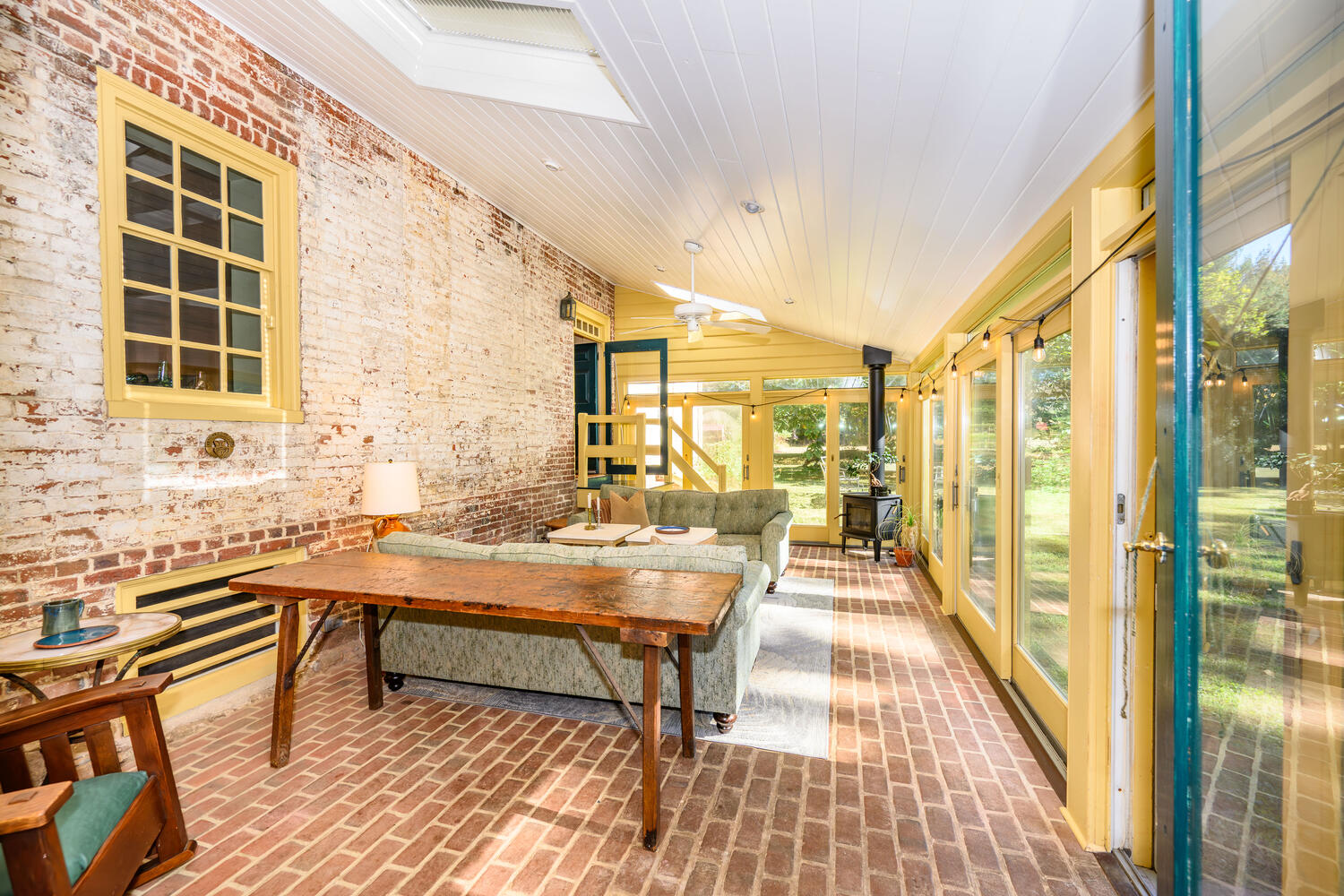
The sunroom’s brick floor and skylights harmonize historic materials with abundant daylight and dynamic ceiling geometry.
The open French door in the informal dining area beckoned me into this exquisite sunroom that spans across the stair hall and the dining room. I admired the space’s interior architecture with its sloped ceiling with skylights to augment the daylight/moonlight from the five pairs of sliding doors that embrace the space. The brick floor is the perfect transition from outdoors to indoors. The mix of brick sizes and colors on the wall was fascinating as it told the history of the house’s construction periods.
The low windows whose sills are just above the floor look into the basement below that is accessed by steps from the family room. In the early days, the space was also used for cold storage and for a respite from the warm weather. The bases of the two chimneys end at the basement floor. Arched openings inside the chimneys both distribute the structural load and provide space for shelving to keep items cool since the enclosure of the thick brick walls maintained an even temperature (also worked well for wine storage too!)
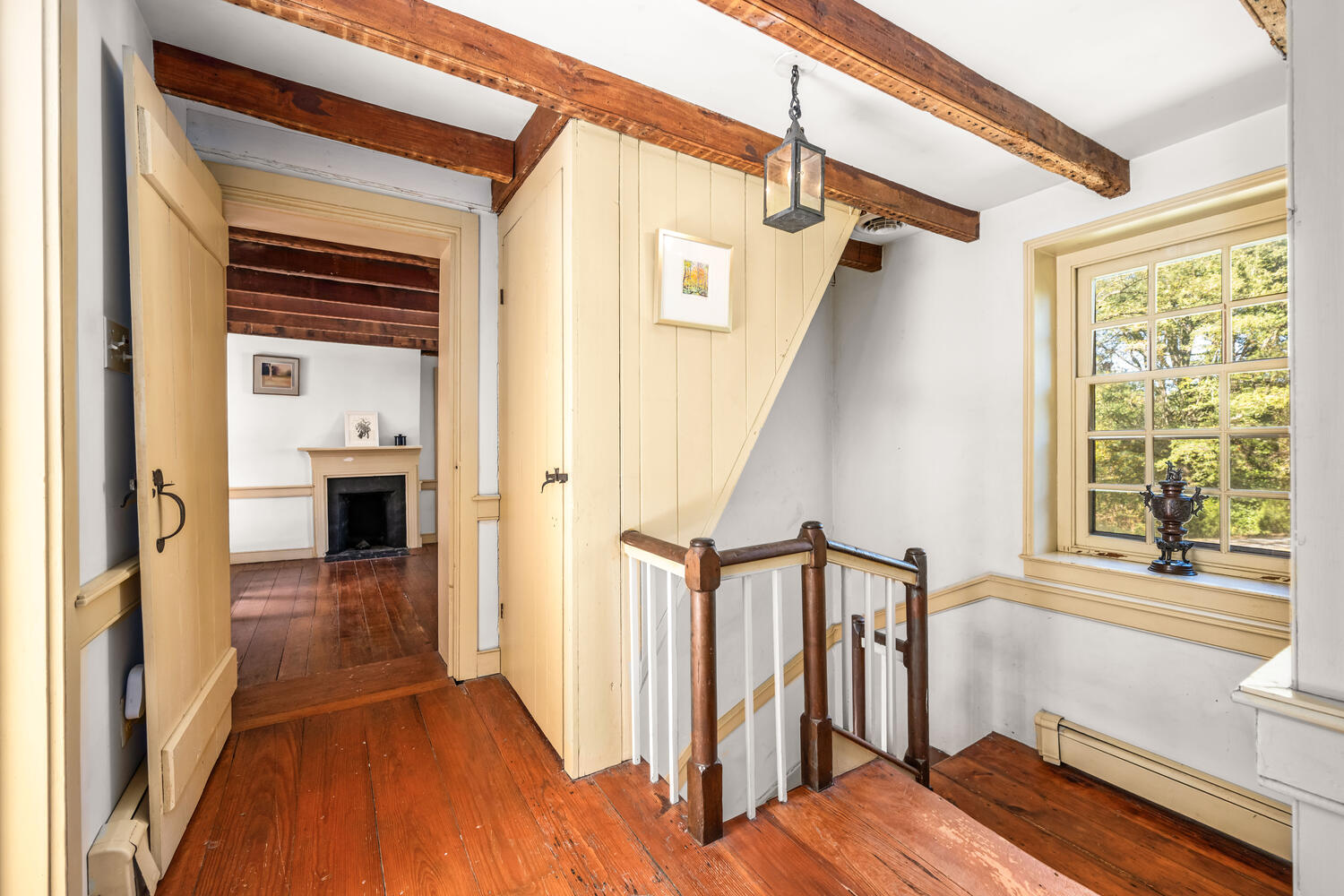
Period hardware meets discrete modern closets along the landing’s expanded hall connecting guest bedrooms above.
To begin my tour of the second floor, I went up the second set of steps in the sunroom that led me back to the stair hall. My hand glided over the walnut cap rail of the banister as I went upward to the expanded landing that blended into a short hall connecting the two guest bedrooms. Opposite the hall is a large bathroom serving both guest bedrooms. Closets with period hardware and paneling that replace historic armoires have been carefully inserted into the hall and both bedrooms.

Exposed beams and rustic vertical paneling frame this inviting guest retreat, accented with handcrafted quilted bedding.
If I were a lucky guest, I would choose this charming room over the living room at the corner of the house. The interior architecture of the exposed beams, accent wall of vertical paneling, and the beautiful wood floors and the quilt by Helen Maenner-Clark in the give and take pattern would be hard to resist!

This expansive bedroom highlights a working loom and a fireplace while retaining original architectural clues and charm.
Across the hall from the corner guest bedroom is this spacious guest bedroom with its own fireplace. I was astounded to find this loom that is the size of a canopy bed and I learned it is very much a working loom for one of the owners. This room is accessed from both the stair hall and steps down to the primary bedroom, so it could have myriad uses.
This room was once divided into two bedrooms. Near the door into the adjacent primary bedroom is another historic clue. Past the exposed beam near the door is an early cursive signature “Harriet Lamb” on another beam. The architectural historian owner explained that is was common for children in the 18th and 19th centuries to mischievously add their signatures on walls and furniture; some homes show initials scratched onto the windowpanes!
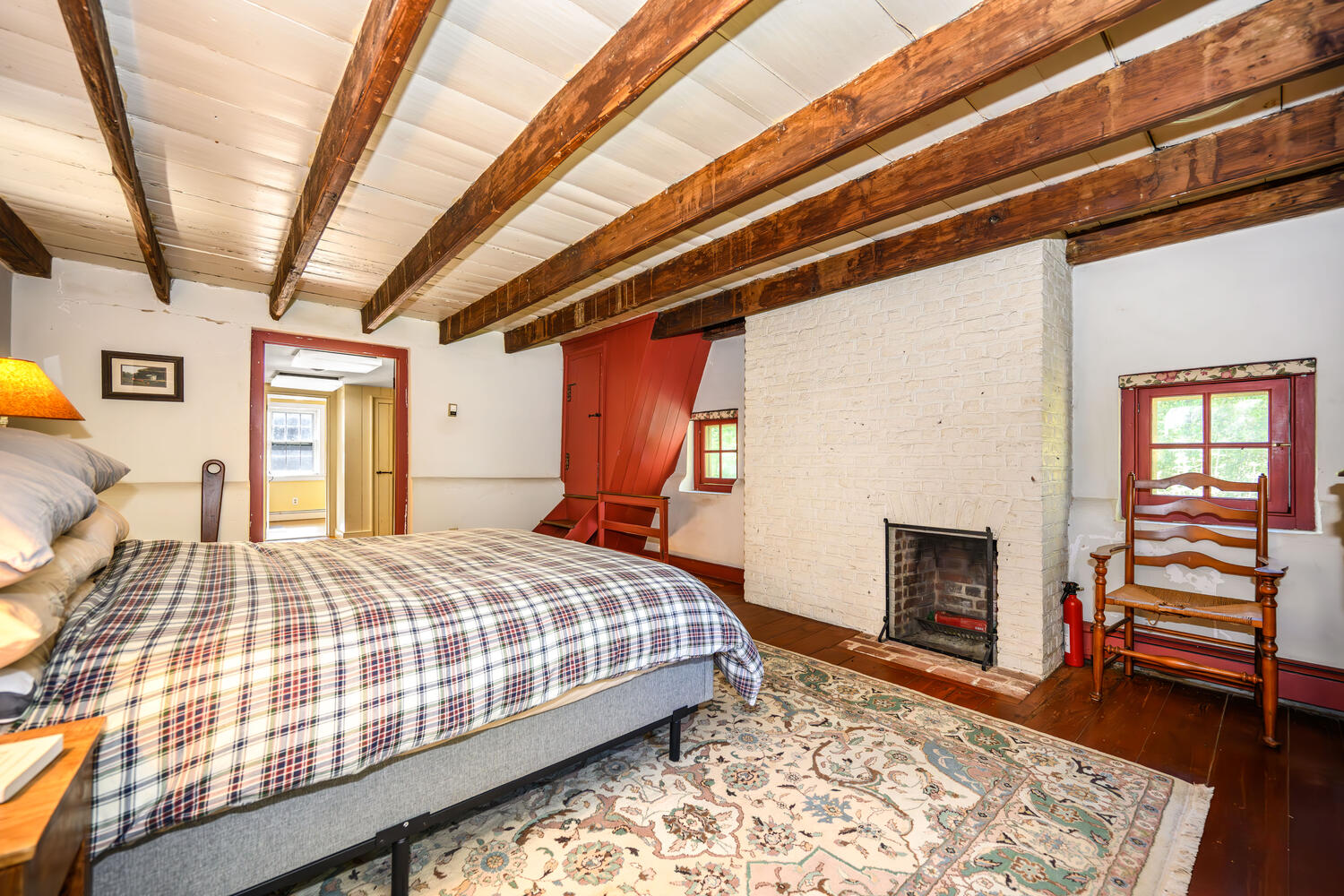
Exposed masonry walls and thick beams create a tranquil corner overlooking the property’s picturesque landscape.
The sumptuous primary suite is located at the other corner of the house and spans over the family room and the kitchen. During the 1985 restoration, the La Mottes left the exterior masonry walls exposed so the thickness of the wall can be appreciated at its depth creates a ledge when the first floor wall transitions to the reduced wall thickness of the second floor’s wall due to the latter’s lighter structural load.
The room is bathed in sunlight from the rear south facing window and the two small windows flanking the chimney at the east wall. The textures of the exposed wood beams below the ceiling’s wide white decking and the colors of the rug, bedspread and the red enclosure for the stair to the family room below create a restful haven for sleep.
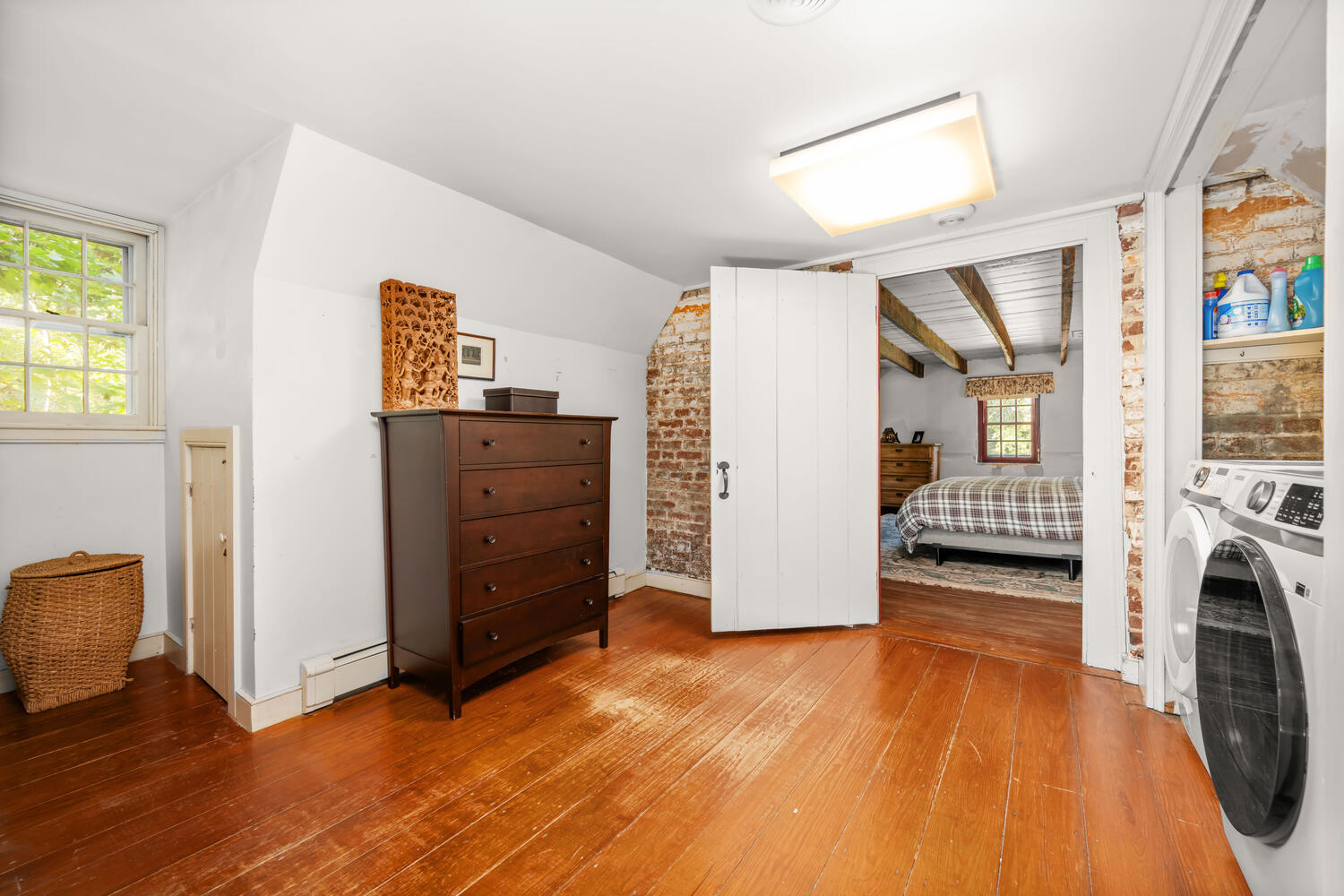
A clever multi-use space with historic details where Reverend LaMotte once crafted sermons at a desk by the window.
Between the primary bedroom and the primary bath is this spacious dressing room that also contains the laundry area and closets and storage under the eaves. The wood chest is located at the spot where Reverend LaMotte would sit at his desk to write his Sunday sermon.
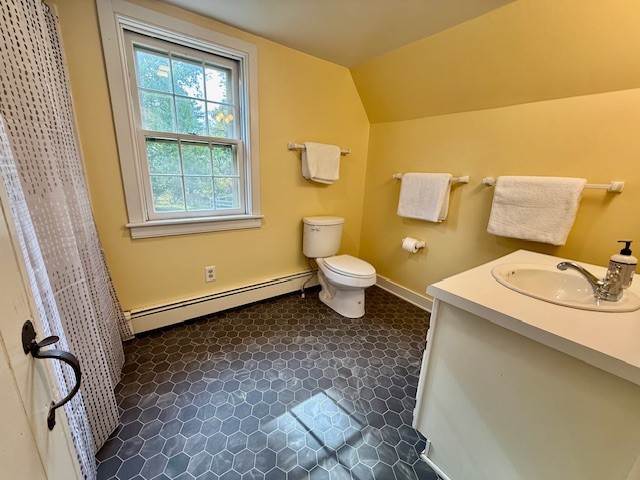
Vaulted ceilings follow the roof’s lines, framing bright gabled views amidst period-inspired cabinetry and warm tones.
Off the dressing room is a large bath with high knee walls and a ceiling plane that follows the outline of the gable roof rafters above to meet the bottom of the collar beam above. The yellow wall accentuates the fixtures and cabinetry.
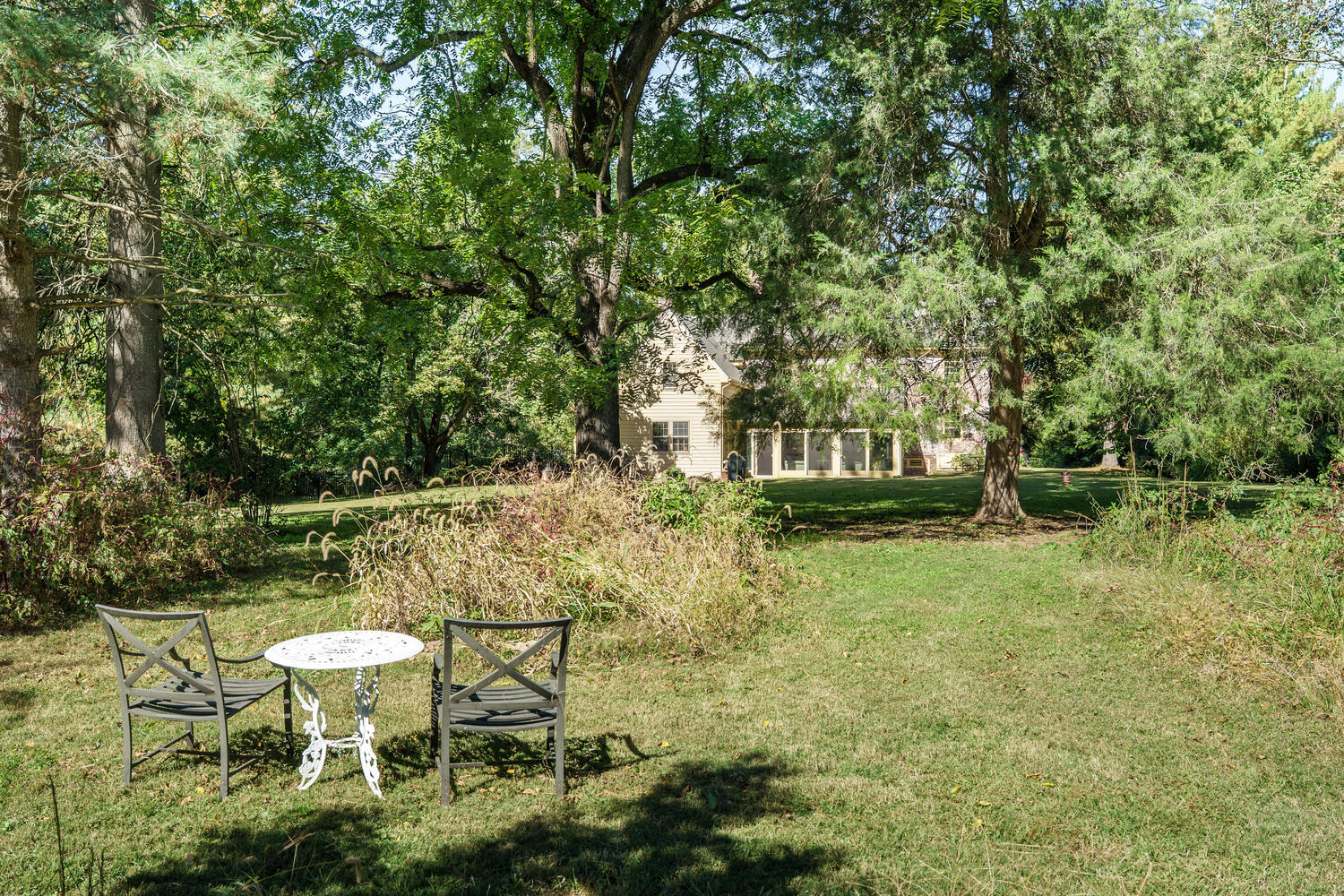
The 6.8-acre property offers lush paths, boxwood hedges, and a modernized studio barn that blends utility with heritage.
The property’s 6.8 acres offer peace and privacy with mature boxwood hedges, mature evergreen and deciduous trees, perennials that return in the spring and wildflowers that bloom in the summer to add color to fallow pastures. Enjoy a daily stroll on the paths that meander throughout the grounds or sit and relax to savor the quiet, broken only by the songs of birds.
The property also has a studio barn that is accessed by its own gravel drive and parking pad. The barn contains a two-bay garage next to a workshop that has its own access and has been updated with insulation and finished in drywall. It also has its high voltage electric, fiber optic internet lines, its own water system and a pellet stove for heat in the winter.
“Friendship House” mid 1898’s restoration that included installation of handcrafted oak windows and mahogany doors with period hardware has been lovingly maintained with materials and preservation sensitive practices by its current owners. They also installed new HVAC units, preservation sensitive insulation, professionally restored windows and two new wood stoves for a turn-key home that offers low maintenance for the next very lucky steward of this remarkable piece of Maryland’s historic residential architecture. As we celebrate Thanksgiving today, I thought it was fitting to feature a house that was built less than 100 years since the Pilgrims landed at Plymouth Rock that has been so magnificently restored-Bravissimmo!!
For more information about this property, contact Liddy Campbell at TTR Sotheby’s International Realty, 410-673-3344 (o), 410-708-5433 (c) or [email protected]. For more photographs or pricing, visit
[email protected] , “Equal Housing Opportunity”.
Photography by Janelle Stroop, 410-310-6838, [email protected]
The Author is indebted to both the Listing Agent and the Owners for sharing their treasure trove of historic documents and photos of the renovations of this property that certainly shows “Friendship” belongs on the National Register of Historic Places!
Contributor Jennifer Martella has pursued dual careers in architecture and real estate since she moved to the Eastern Shore in 2004. She has reestablished her architectural practice for residential and commercial projects and is a real estate agent for Meredith Fine Properties. She especially enjoys using her architectural expertise to help buyers envision how they could modify a potential property. Her Italian heritage led her to Piazza Italian Market, where she hosts wine tastings every Friday and Saturday afternoons.
